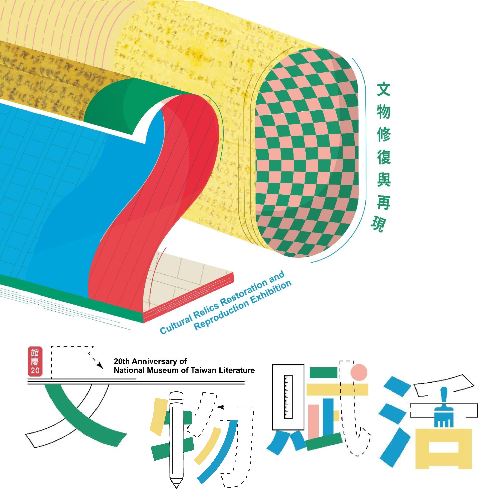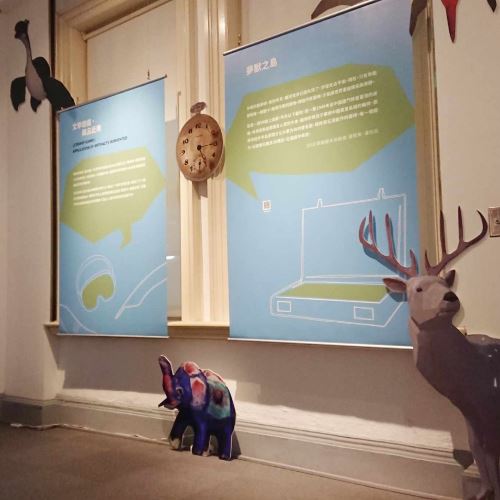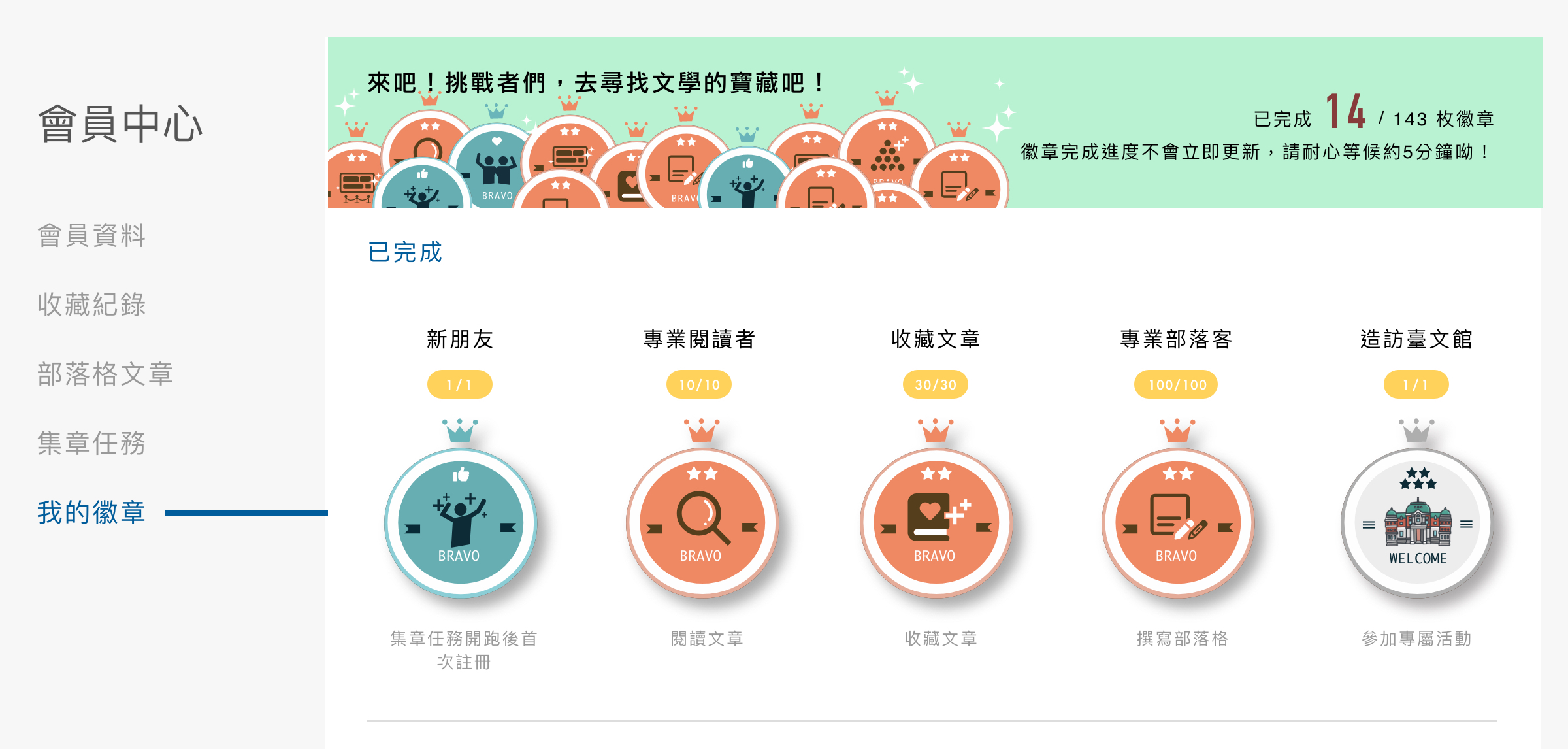◍ Culinary Art in Literature – Food in Literary Translation
◍ Wearable Literature – Apparel and Accessory in Literary Translation
◍ Hipsters' Playground—Literary Keepsakes and Paraphernalia in Literary Translation
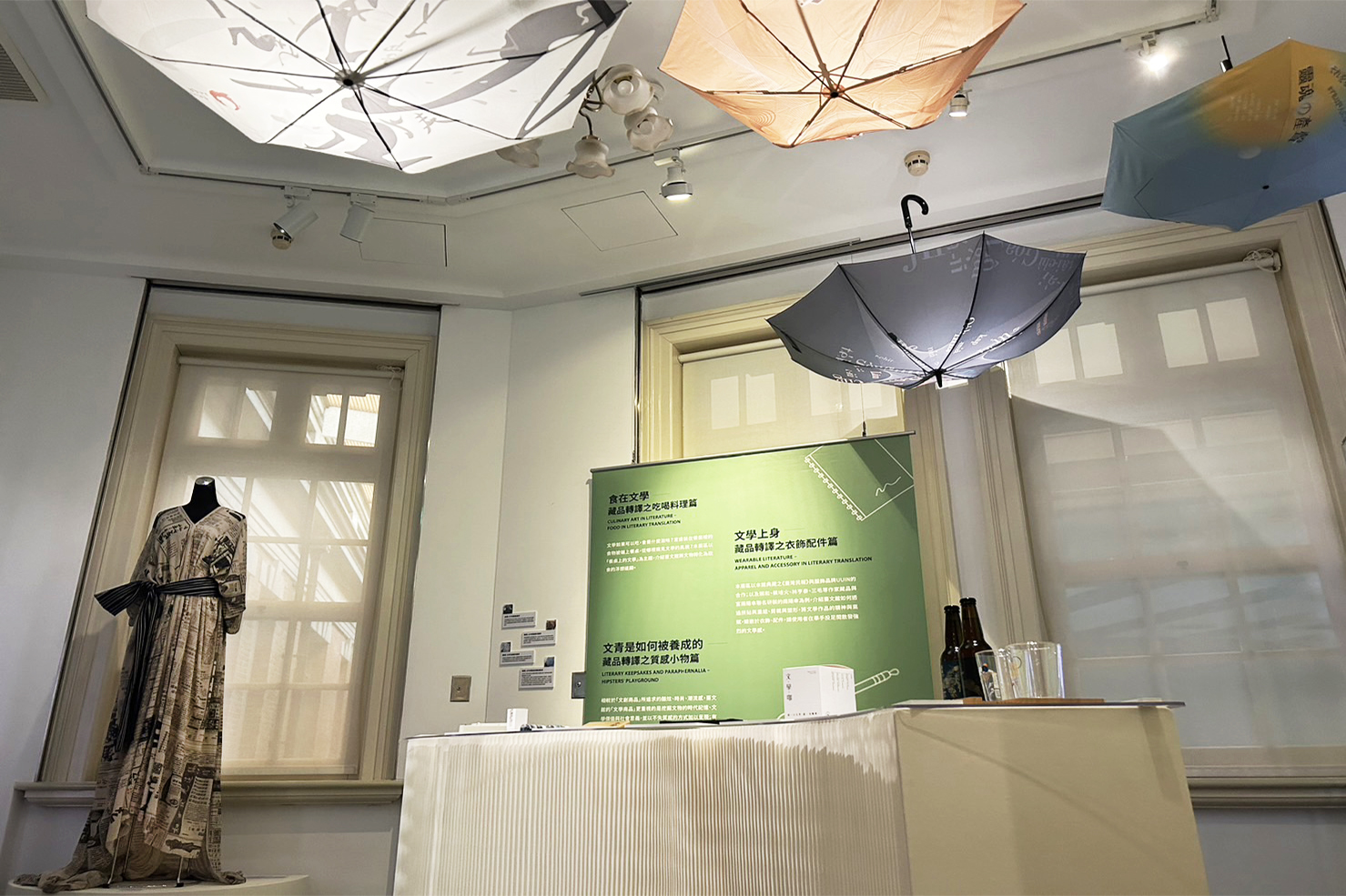
"Translation" is a word that originated from the field of genetics. In recent years, it has been used to indicate all types of connections and interactions between cross-disciplinary media. It is the most popular key word in the culture scene. The process of translation allows cells to turn into protein; it also allows literary writings on paper to turn into games, animation, movies, and all types of merchandise. Now, we will show you how the museum changes the sounds and images of the artefacts through translation; the museum disguises them luxuriously and turns them into daily objects.
Culinary Art in Literature – Food in Literary Translation
If literature is edible, what would it taste like? If food on a plate is served on a table, where can you see the literature in that? This article focuses on "the literature on the dining table" and introduces how the museum transforms artefacts into food.
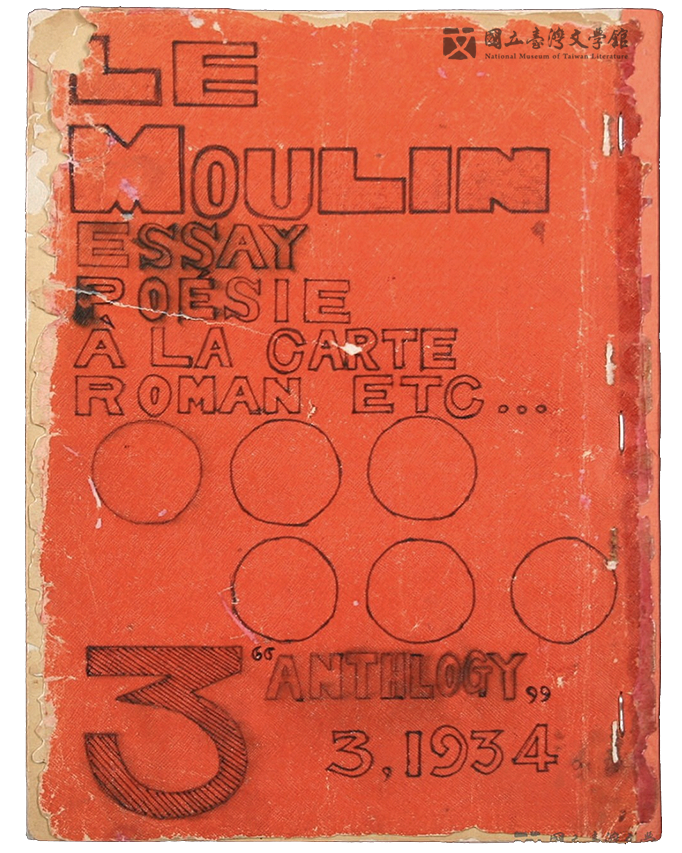
⭔ LE MOULIN 3
Established in 1933, "Windmill Poetry Society" was led by Yang Chichang and featured writers such as Lin Xiuer and Li Yecang. It was the first to introduce surrealistic literature to Taiwan and published the journal LE MOULIN. Not only did it keep pace with global literary trends, but it also broadened and deepened the aesthetic experience of new poetry in Taiwan. The journal was published in four issues, with each issue printing 75 copies and containing poetry, fiction, essays, etc. The library's collection of the third issue, published in March 1934, is the only known existing publication of the Windmill Poetry Society, and serves as important historical material for studying the evolution and dissemination of literary ideas in Taiwan during the Japanese colonial period. (Kept in National Museum of Taiwan Literature)
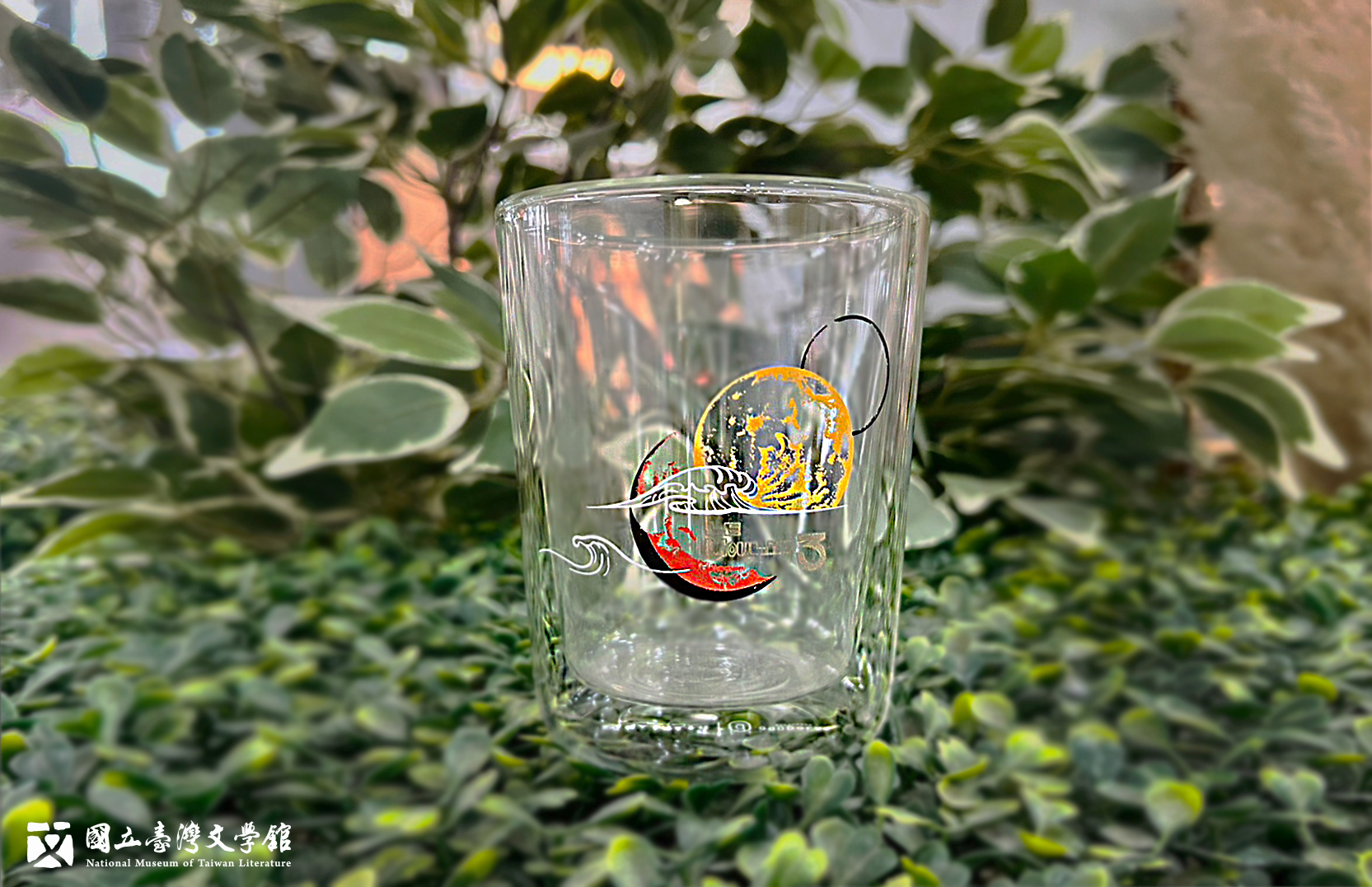
⭔ Moonlight Reflections Double Glass Cup
The illustration here was inspired by another of NMTL's archive treasures, The Journal of Le Moulin Poetry Society, Volume 3, and a line from a Japanese-language poem in this journal by Lee Chang-jui entitled 'Hurubita Tei-en' (Ancient Garden). Under the strictures of night, a young woman yearns for freedom that remains tauntingly out of her reach. Waves crashing upon a rocky shore symbolize her desires for liberation. Yet moonlight keeps her trapped inside this imaginary garden.
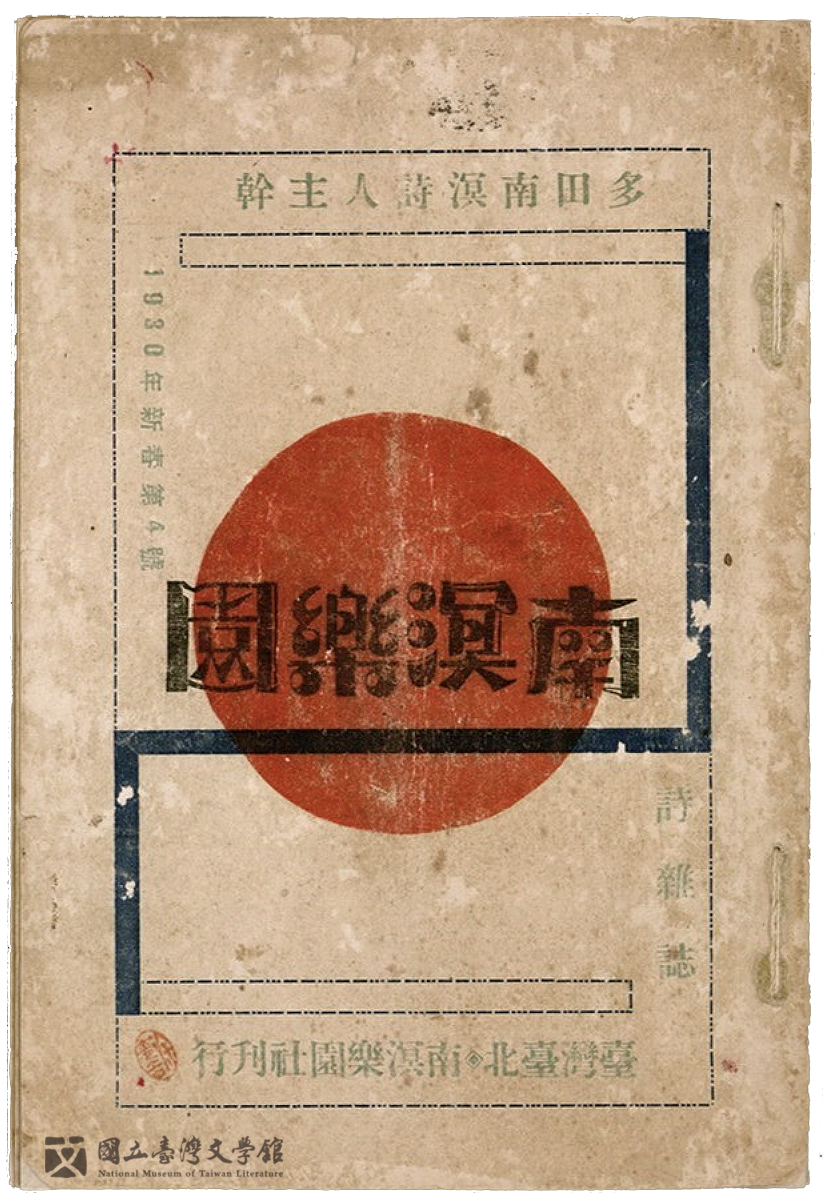
⭔ NAM MIN PARADISE Issue 4
NAM MIN PARADISE was first published in October 1929, issued by the "Nam Min Paradise Society" led by poet Tada Nam Min (Tada Toshiro). Several poets from the salt-producing regions like Kuo Shui-tan, Chen Qi-yun, Xu Qing-ji, and Wang Deng-shan also joined the society. Therefore, this publication serves as important historical material supplementing the research on writers from the salt-producing regions. Issue 4 mainly contains literary works and society news. The literary works are primarily poems, while society news includes society rules, rules for membership fees, individual and branch updates, publishing information, etc. The stored issue is the only known existing copy in Taiwan, and the table of contents bears a collection stamp from Xu Qingji, further highlighting its invaluable worth. (Kept in National Museum of Taiwan Literature)
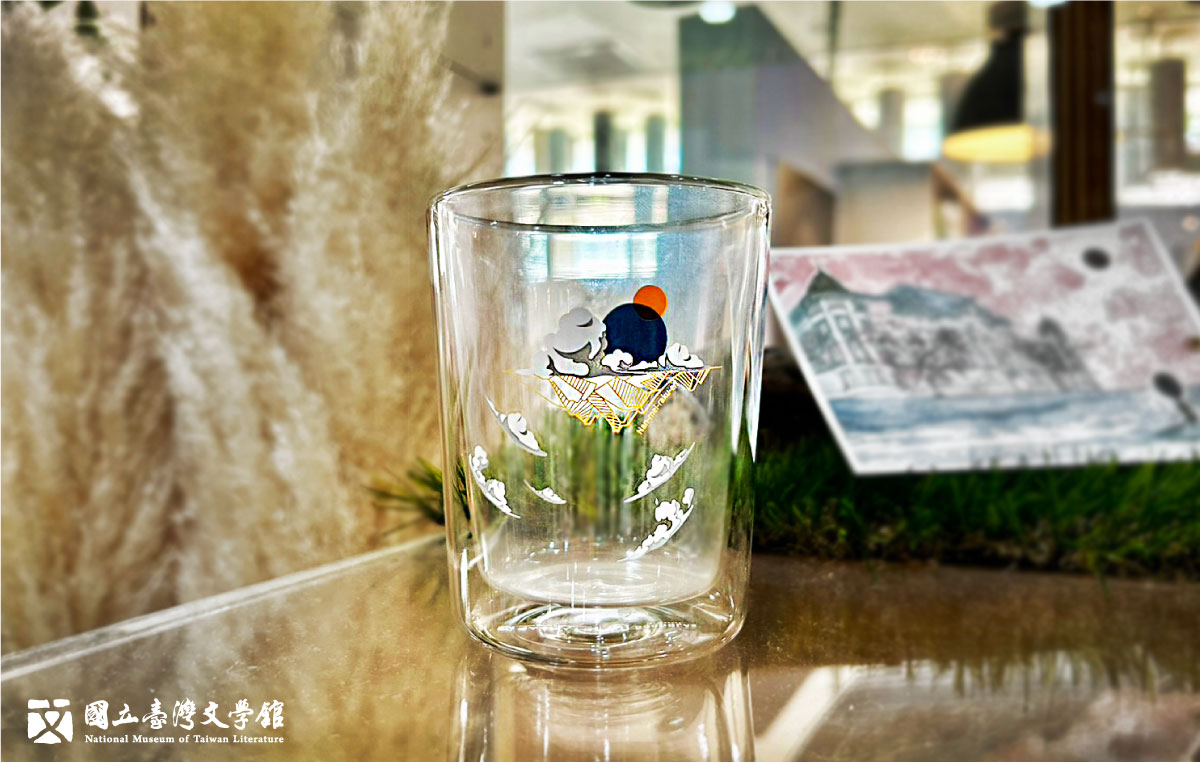
⭔ Fair Autumn Double Glass Cup
The illustration here was inspired by one of NMTL's archive treasures, The Journal of Nanmei Rakuenshya, Volume 4, and a line from a Japanese-language poem in this journal by Kuo Shui-tan entitled 'Aki no Kokoro' (Autumn Heart). The line reads: "Clear and spiring skies attest to autumn's arrival". Inspired by the skies above, mountainous clouds and dark blue and crimson-orange hues are used in poetic diction as symbols of quietude and loneliness and of separation and sorrow. This island is the tapestry upon which poet Kuo Shui-tan makes his inspired wanderings and expresses his passion for creativity.
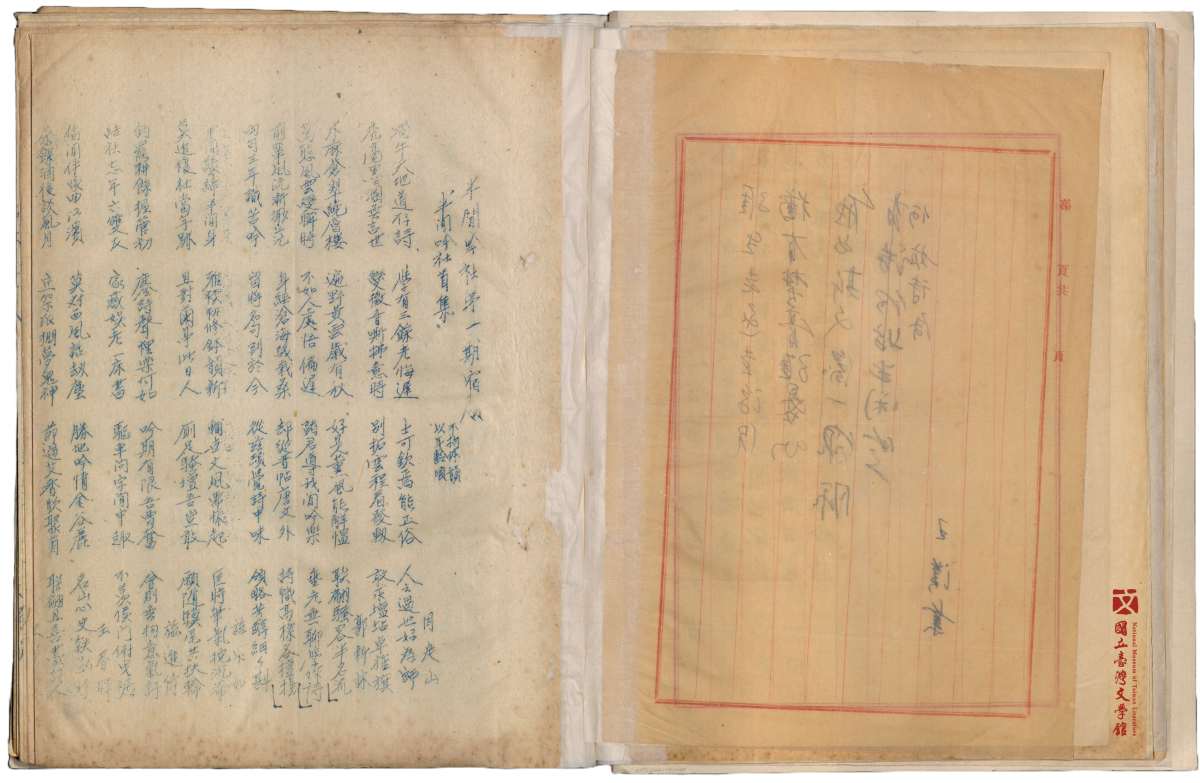
⭔ FIRST COLLECTION OF PAN HSIEN YIN SHE by Chou Ting-shan
 This book is a collection of poetry by members of the Taiwanese classical poetry society, "Banxian Yinshe." In 1958, Lukang's literary figure Zhou Dingshan established "Banxian Yinshe" to promote classical Chinese poetry. The participants were mainly not poets or literati, but people from all walks of life. To encourage the exchange of poetic skills, the society would periodically release "themes" as base for members to compose poems based on. These "themes" had a wide range, including natural phenomena, festivals, historical references, and new events. On the one hand, the society integrated life into poetry to promote classical poetry composition. On the other, it mutually encouraged members, enhancing creative skills and becoming a poetic paradise where members could "steal half a day of leisure." (Kept in National Museum of Taiwan Literature)
This book is a collection of poetry by members of the Taiwanese classical poetry society, "Banxian Yinshe." In 1958, Lukang's literary figure Zhou Dingshan established "Banxian Yinshe" to promote classical Chinese poetry. The participants were mainly not poets or literati, but people from all walks of life. To encourage the exchange of poetic skills, the society would periodically release "themes" as base for members to compose poems based on. These "themes" had a wide range, including natural phenomena, festivals, historical references, and new events. On the one hand, the society integrated life into poetry to promote classical poetry composition. On the other, it mutually encouraged members, enhancing creative skills and becoming a poetic paradise where members could "steal half a day of leisure." (Kept in National Museum of Taiwan Literature)
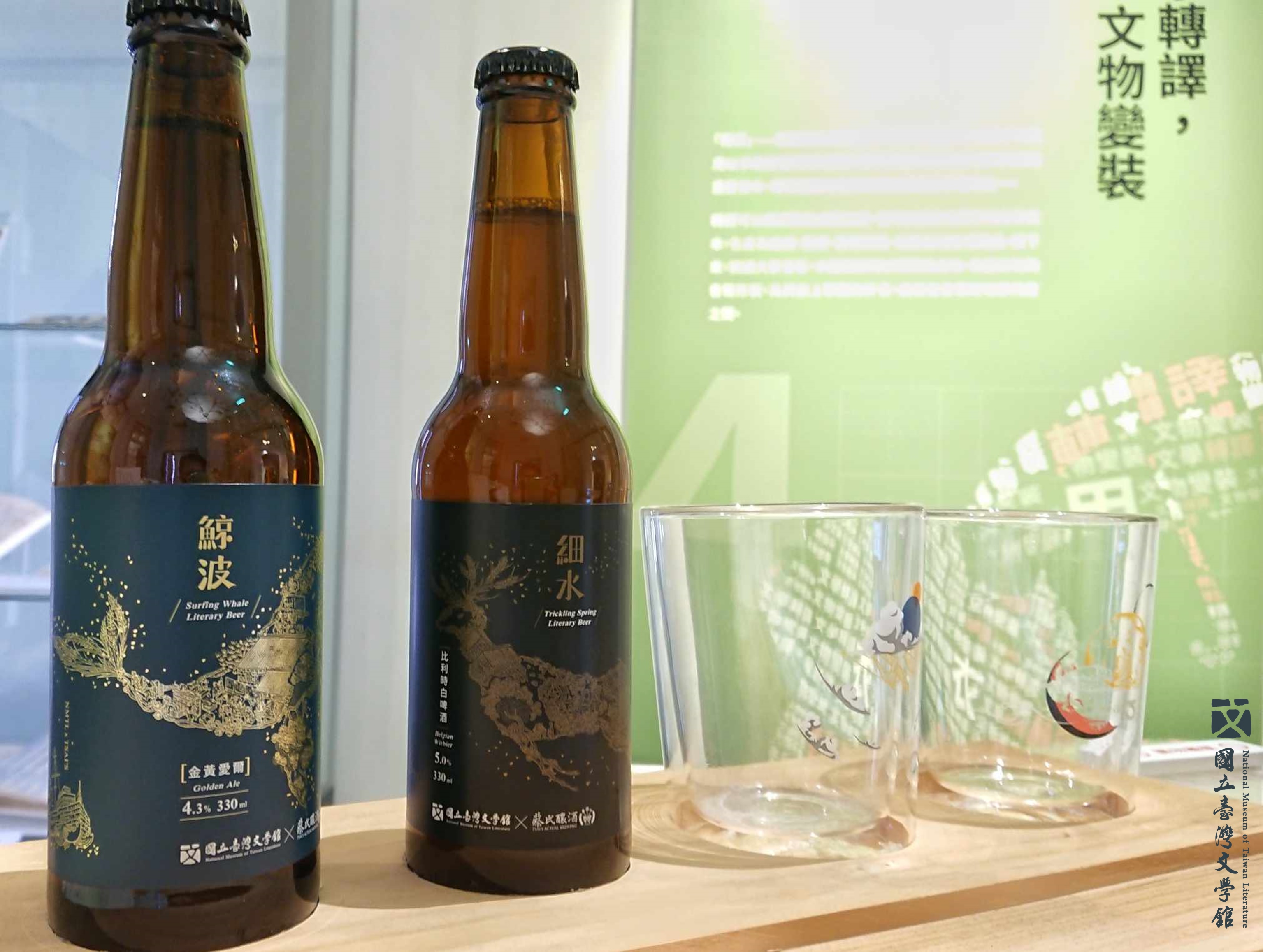
⭔ Craft Beer: Whale Wave, Fine Water
Named after poetic lines, these important works of Taiwan literature leap into people's daily lives, allowing them to feel the warmth of literature while sipping. The concept of craft beer is derived from the poem in FIRST COLLECTION OF PAN HSIEN YIN SHE—"Fine Water" comes from the line "The big hole accommodates fine water for a thousand years, why the need for long hair to sing uneven songs." The beer is brewed by "Cai's Brewery," with a malt aroma accompanied by refreshing lemon and a smooth, slightly salty and sweet taste. Another variant "Whale Wave" is inspired by "As if Yuyang drums were beat to roar, like driving ten thousand cavalry to kick whale waves," characterized by its unique floral and herbal aroma, blending literature into the rich wine, and intoxicating before one even drinks.
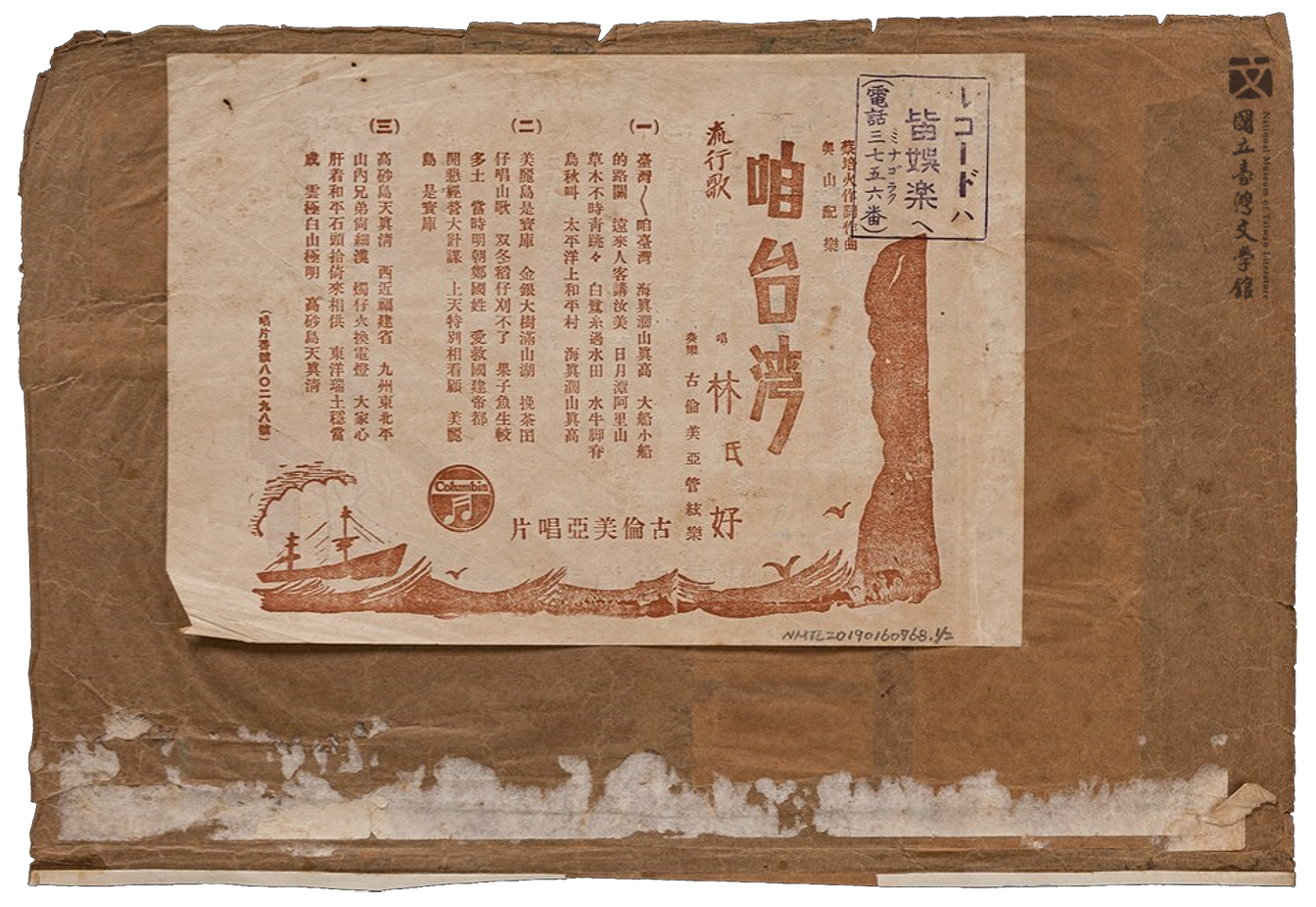
⭔ Tsai Pei-huo's "Lán Tâi-uân"
Lán Tâi-uân was composed by Tsai Pei-huo in April 1929, with music by Aoyama and vocals by Lin Hau. The song is filled with a strong sense of local identity, singing the dignity and sentiments of the colonized people. (Kept in National Museum of Taiwan Literature)
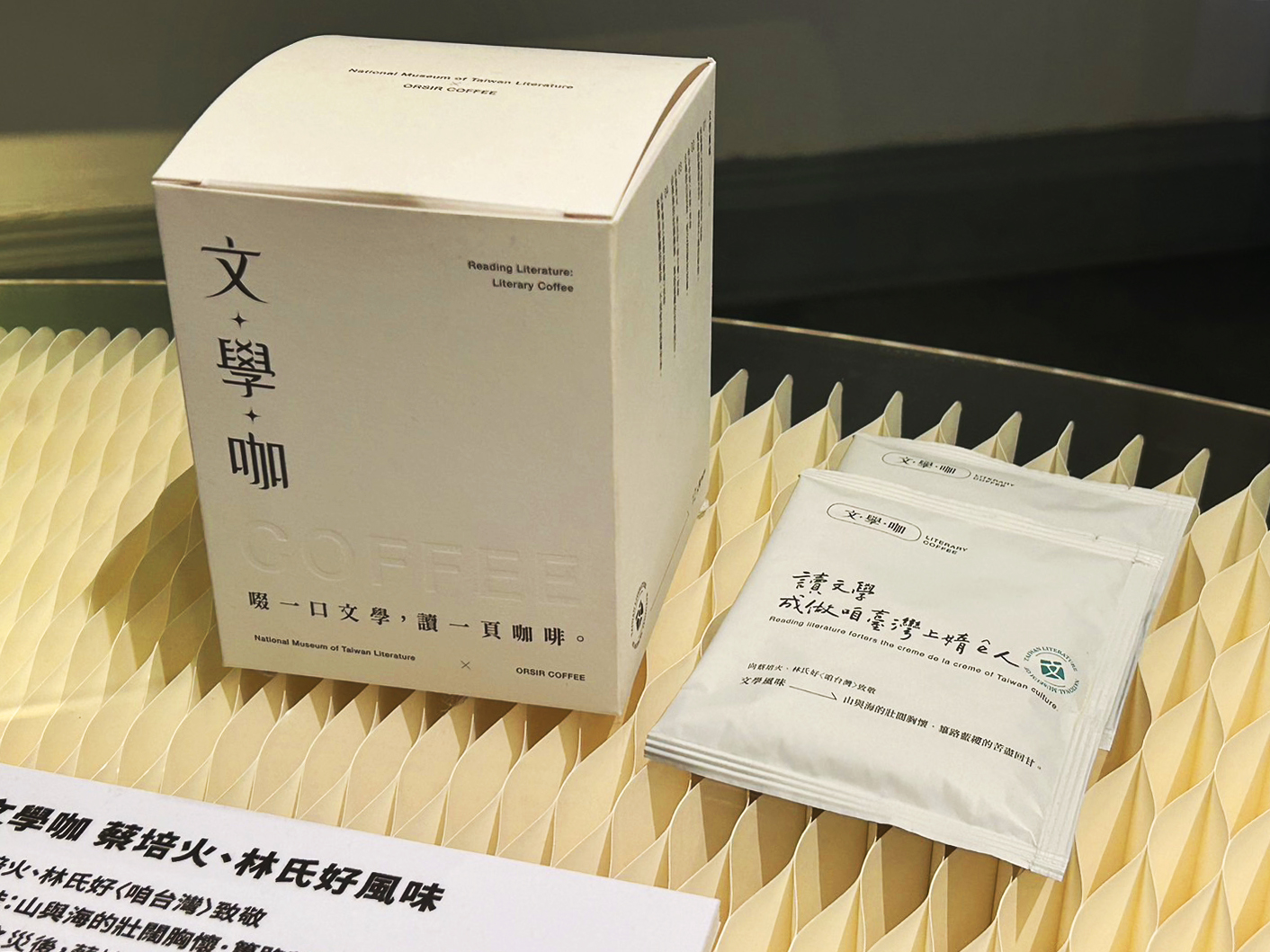
⭔ Literary Café Tsai Pei-huo, Lin Hau's Good Flavor
Paying tribute to Tsai Pei-huo, Lin Hau "Lán Tâi-uân" Literary Flavor: The grandeur of mountains and seas. The bitterness turns sweet after hardships. After being imprisoned, Tsai Pei-huo's love for Taiwan was not only not extinguished but also further ignited his recognition that "Taiwan is the Taiwan of Taiwanese people." Sun Moon Lake and Alishan, still popular tourist destinations today, were already among the coveted "Eight Sceneries of Taiwan" for the Taiwanese in the 1920s. Whenever there are unreasonable shackles of colonial rule, the endless greenery always revives the nearly dead heart.

Wearable Literature –
Apparel and Accessory in Literary Translation
This article is about THE TAIWAN MINPAO, which is a part of museum's collection, and its collaboration with UUIN (one clothing brand). By taking the example of the umbrella made by F-SEASONS Umbrella, which is inspired by artefacts of Lai Ho, Tsai Pei-huo, Lin Heng-tai, and Sanmao, it introduces how the museum embedded the spirit of literature work into clothes and accessories by collaging, reorganizing, cutting, and shaping so that users can emanate a strong literary aura in daily life.
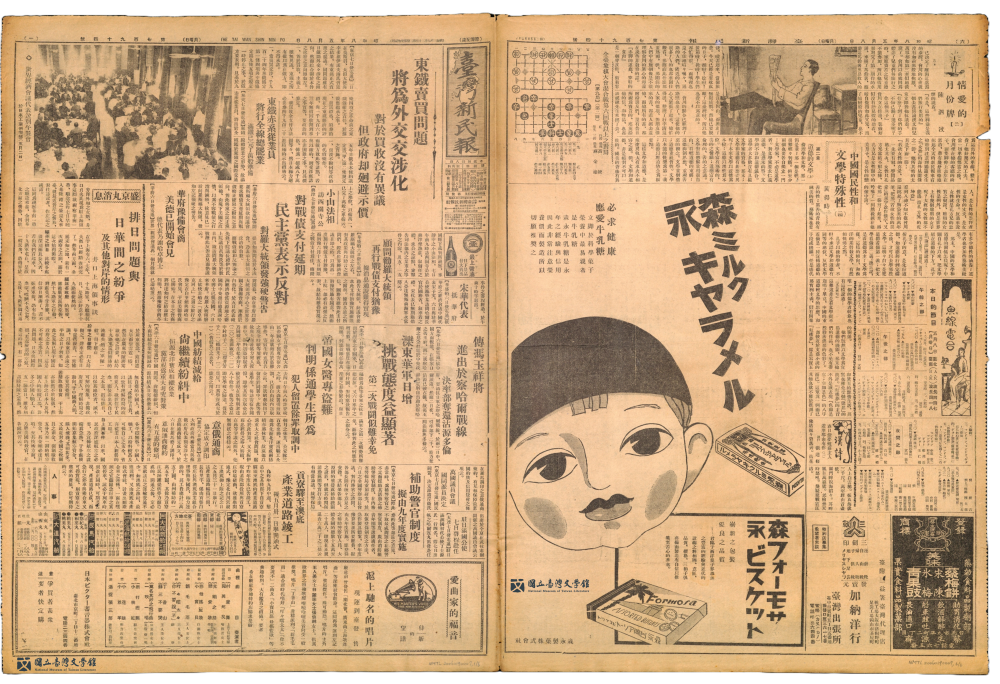
⭔ TAIWAN NEW PEOPLE NEWSPAPER
Founded in Tokyo in April 1923, THE TAIWAN MINPAO was the successor to TAIWAN YOUTH JOURNAL and TAIWAN, with content written in Chinese script. In 1930, it was renamed and reorganized with increased fund as TAIWAN NEW PEOPLE NEWSPAPER. This newspaper was the first paper established by Taiwanese people during the Japanese colonial period. It was an essential medium for Taiwanese to receive the latest news and advertisements a century ago, dubbed as "the only voice of the Taiwanese," providing a platform for Taiwanese writers' literary works and discussions. To increase readership, TAIWAN NEW PEOPLE NEWSPAPER tried to publish "news novels" that combined trending fashion with hot current events and echoed news reports. The serialized content was varied, covering everything from the pursuit of free love to Taiwan's economic commentary on Manchukuo, as well as discussions on waging war, fully reflecting the close bond connecting people's life, political and economic situations, and imperial aggression. In August 2000, Professor Nakajima Toshiro, a Japanese researcher of Taiwan literature, donated the TAIWAN NEW PEOPLE NEWSPAPER collection from May to November 1933 to National Museum of Taiwan Literature. The only known unique copy nowadays, it includes many works by Taiwanese writers during the Japanese colonial period and new materials on the "native literature debate," greatly impacting Taiwan literature research. (Kept in National Museum of Taiwan Literature)

⭔ MOGA TAIWAN NEW PEOPLE NEWSPAPER Printing: Japanese-style Tie Chiffon Dress
UUIN Spring/Summer 2023 Collection is inspired by the 1920s MOGA "Modern Girls," following the historical context and inspired by healthcare workers, reorganizing and printing TAIWAN NEW PEOPLE NEWSPAPER as a tattoo dress, that symbolizes "knowledge embodied." Echoing the "malnutrition of knowledge" proposed by Dr. Chiang Wei-shui 100 years ago, and THE TAIWAN MINPAO (predecessor of TAIWAN NEW PEOPLE NEWSPAPER) he co-founded, that stirred the transmission and awakening of cultural thoughts, as well as sowing the seeds for the rise of female consciousness.
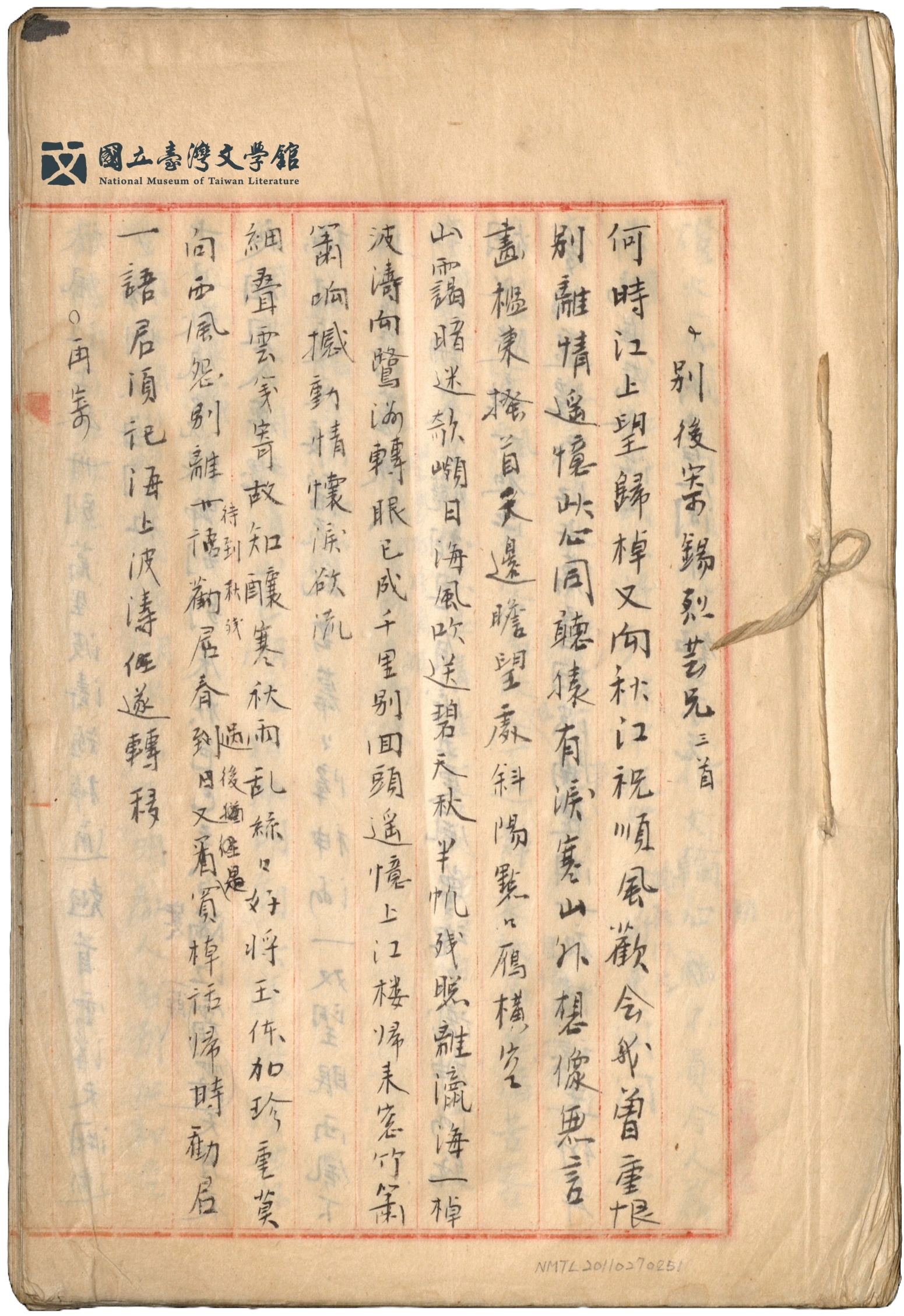
⭔ Lai Ho's Poetry Manuscript "Poems Sent to Shi Xilie and Yun Brother after Parting, Among Others"
This manuscript is a compilation of over a hundred poems transcribed by Lai Ho. The content primarily consists of personal emotional expression, as well as response poetry with Shi Xilie or classmates from Xiaoyitang. It also includes poems inspired by the landscapes Lai Ho encountered during his leisurely travels. The manuscript even includes the first poem Lai Ho wrote when he was 15 years old in 1908.(Kept in National Museum of Taiwan Literature)
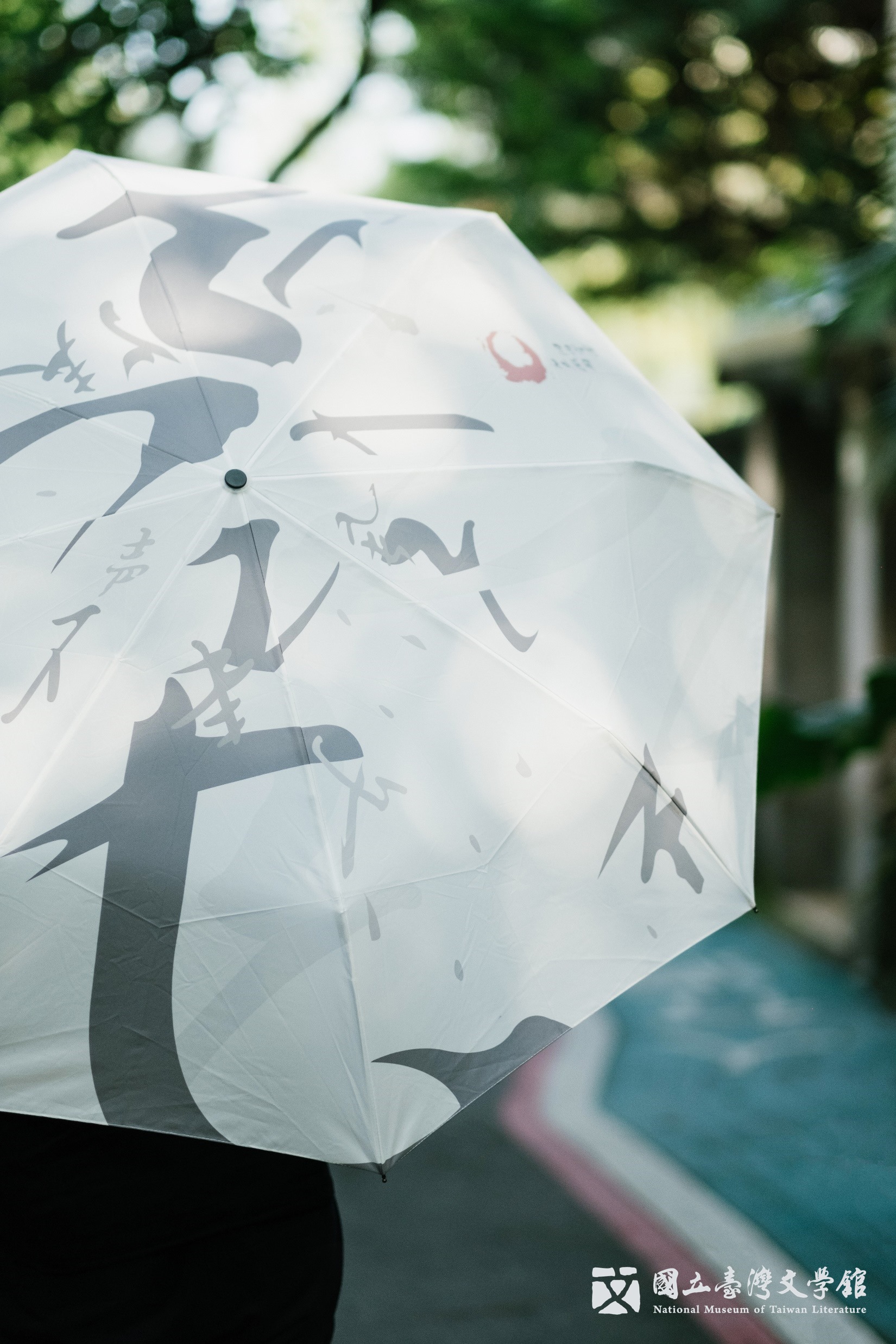
⭔ Downpour 25 auto folding umbrella
Lai Ho's hand-penned words from NMTL's archives are emblazoned across the face of this umbrella. Capturing this author's passionate struggle against the sorrows of his day, let these words and this umbrella's water-resistant design be your best response to a sudden downpour.(Photographed by 4samantha)
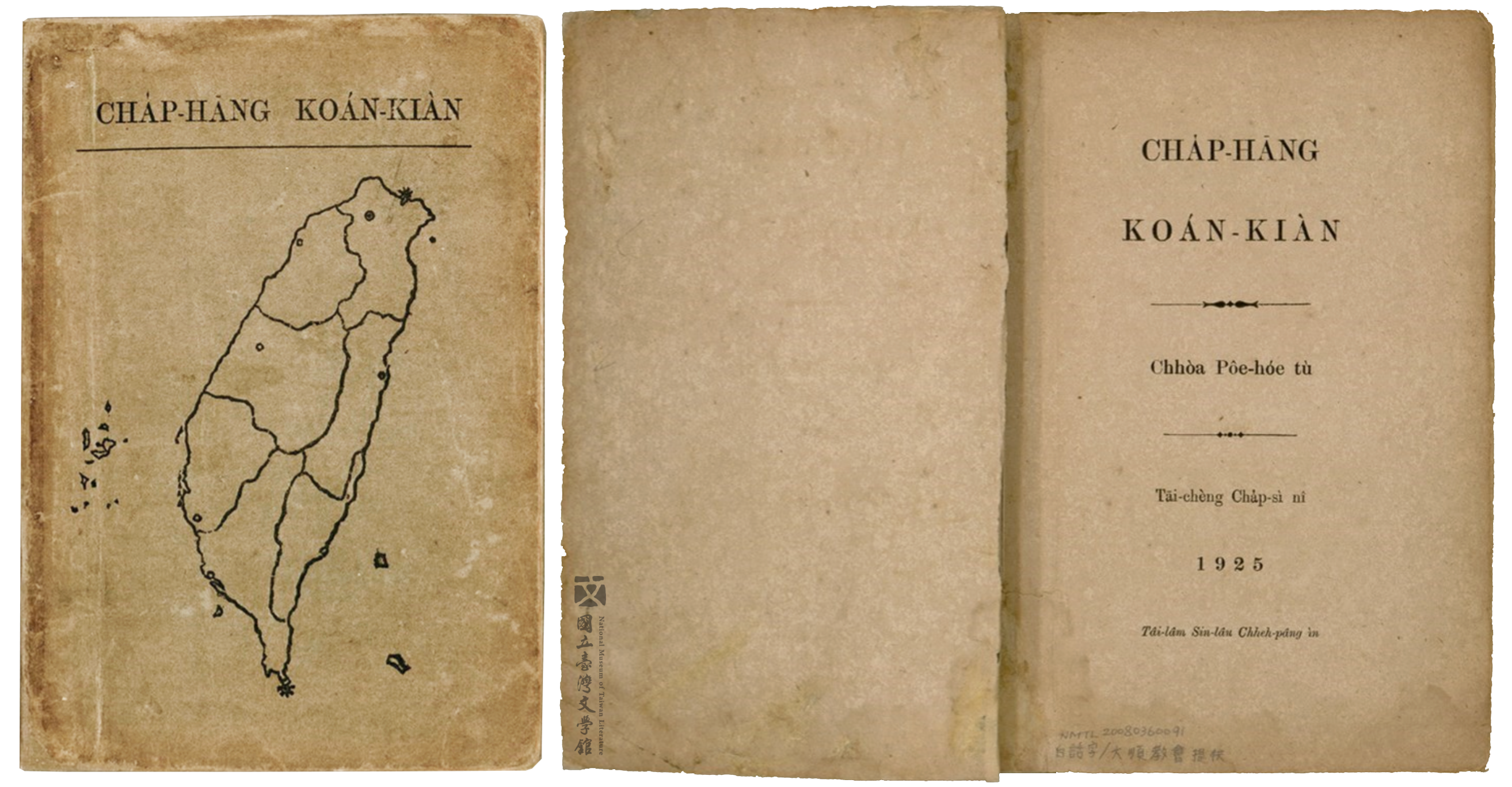
⭔ Tsai Pei-huo's Chàp-hāng Kóan-kiàn
Aiming to enable the general public to gain knowledge quickly, Tsai Pei-huo actively promoted the enlightenment and cultural movement of Taiwanese people through Romanization. He began writing CHA̍P-HĀNG KOÁN-KIÀN in 1923, which was published in 1925. This book is the only argumentative essay collection from the Japanese colonial period. Written entirely in vernacular script, the book presents Taiwan's then-most-needed "Ten Social Educations" from a modern perspective. Topics include the identity of Taiwanese people, civilization vs. barbarism, women, benevolence, and culture, offering a deep analysis and discussion on the uniqueness of Taiwan and its people with the aim to enlighten minds and cultivate morals. (Kept in National Museum of Taiwan Literature)
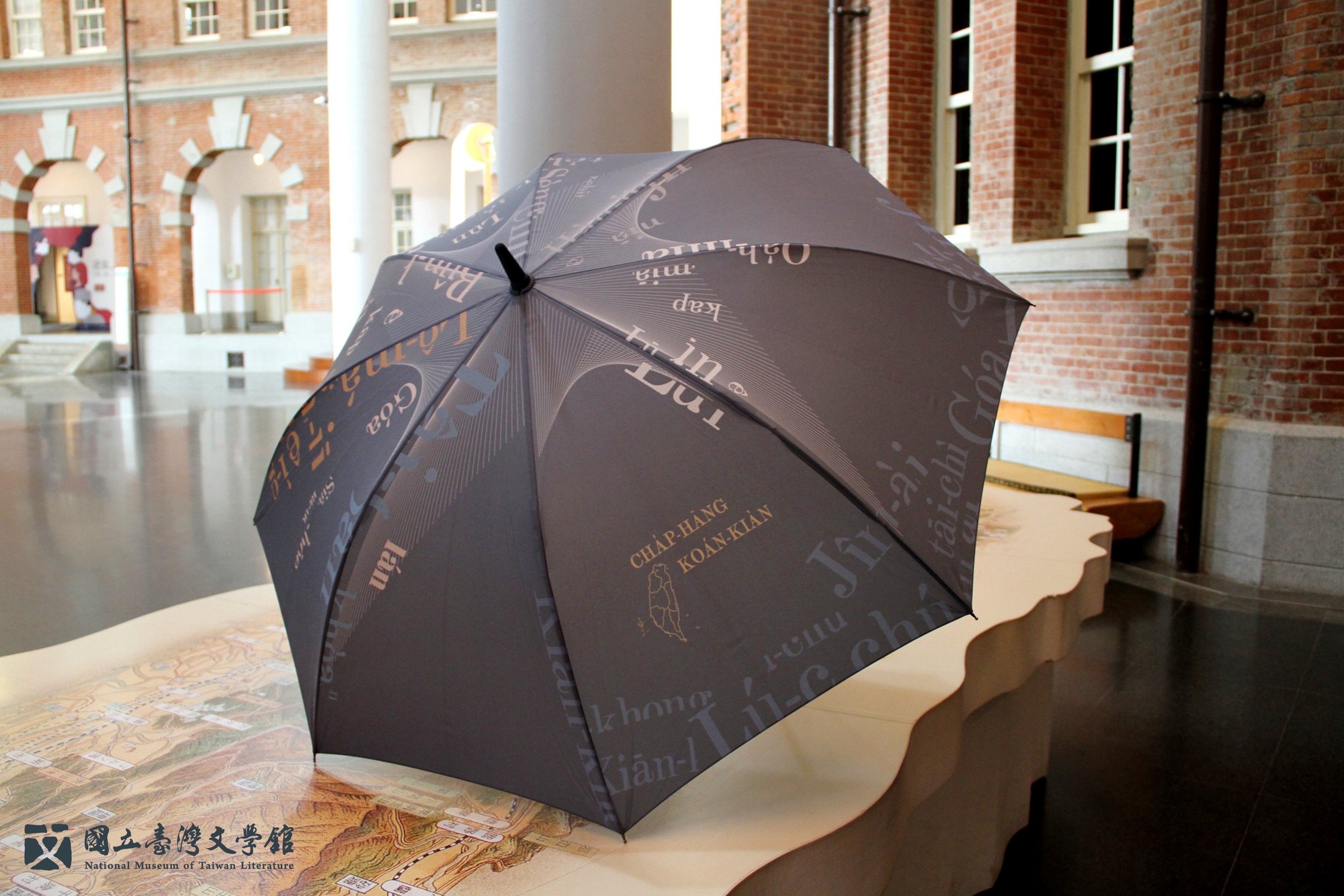
⭔ Windstorm 27 auto open cane umbrella
The image of Taiwan and the text from the chapter advocating Pe̍h-ōe-jī (POJ) printed on the face of this umbrella are reprinted from the cover of an original edition of Chàp-hāng Kóan-kiàn in NMTL's archives. Contemporary Taiwanese yearnings for linguistic consciousness continue to have relevance today. This umbrella's sturdy, wind-resistant frame will help see you through whatever lies ahead.

⭔ Sanmao's "The First White Horse"
The "White Horse" was Sanmao and Jose's first small car, frugally saved up for. Over three years, it robustly carried the couple almost 180,000 kilometers, sometimes from Western Sahara across to the Algerian border, and sometimes through Mauritania to the Republic of Benin, "performing so well it drew grateful tears." When it became old and decrepit, Sanmao reluctantly sold it to a neighbor. A few days later, the license plate was replaced, so Sanmao quickly brought back this "horse's tail" as a final keepsake. (Kept in National Museum of Taiwan Literature)
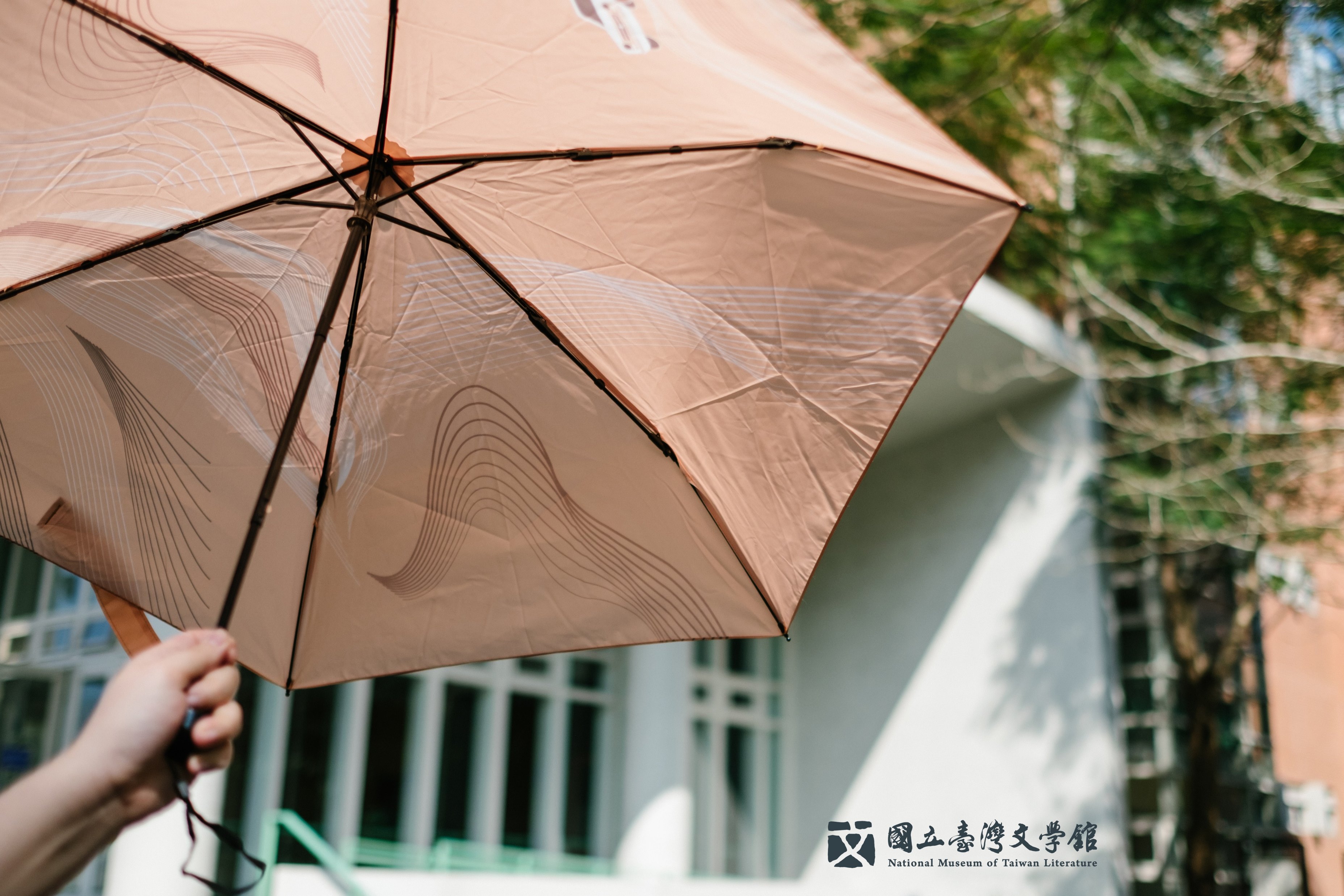
⭔ Heatwave 21 compact folding umbrella The ridgeline represents shifting sands and the white car in its midst suggests adventure and escape. This sets the stage for this umbrella's most unique feature – a metal replica of the license plate that once graced Sanmao and José's car nicknamed 'White Steed', which endures as a symbol of Sanmao's unquenchable desire for freedom. Let this UV-blocker umbrella keep you safe from the torrid sun during all of your adventures.(Photographed by 4samantha)
The ridgeline represents shifting sands and the white car in its midst suggests adventure and escape. This sets the stage for this umbrella's most unique feature – a metal replica of the license plate that once graced Sanmao and José's car nicknamed 'White Steed', which endures as a symbol of Sanmao's unquenchable desire for freedom. Let this UV-blocker umbrella keep you safe from the torrid sun during all of your adventures.(Photographed by 4samantha)
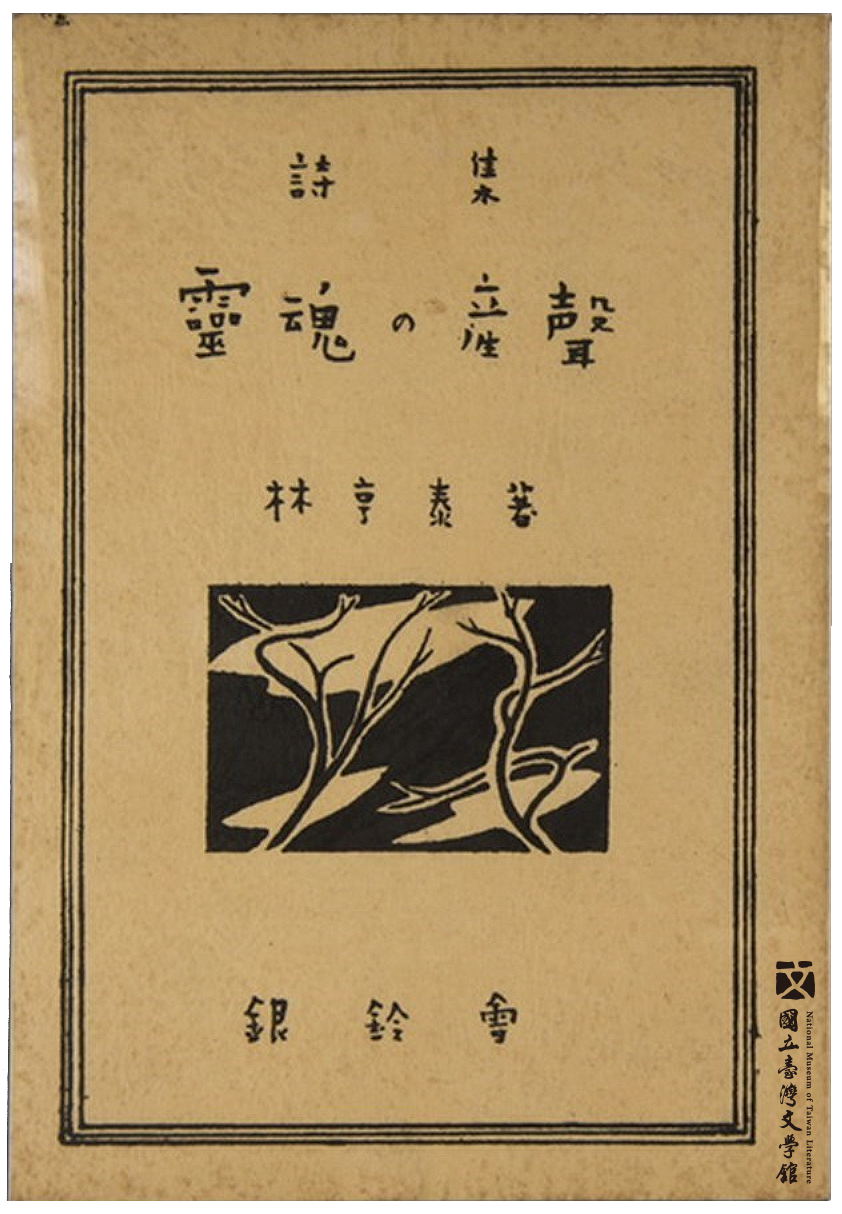
⭔ Lin Heng-tai's THE SOUND OF THE SOUL
Lin Heng-tai (1924-2023) was an important poet of the "translingual generation," writing under the pen names Hengren and Hengtai. He was from Changhua and graduated from the Education Department of Taiwan Normal College. In 1947, he joined the literary group "Ying Lin Arts Association," founded by Zhu Shi, Zhang Yan-xun, and others, and frequently published works in its magazine, TREND PERIODICAL. His poetry, through intellectual introspection and the pursuit of inner musicality, accurately captured the pulse of his era. It combined local spirit and modern artistry; he was not just a calm theorist but also an avant-garde practitioner. THE SOUND OF THE SOUL was Lin Heng-tai's first poetry collection, featuring 37 poems, including "Moonlight Fragrance" and "Dream," written from 1942 to 1949 during his time in the "Ying Lin Arts Association." Most were written in Japanese, with only a few in Chinese, serving as a summary of his poetic works from the 1940s. He received several honors, including the "Taiwan Literature Oxford Award," the "National Literary Award," and the Wu San-lien Literature Award. (Kept in National Museum of Taiwan Literature)
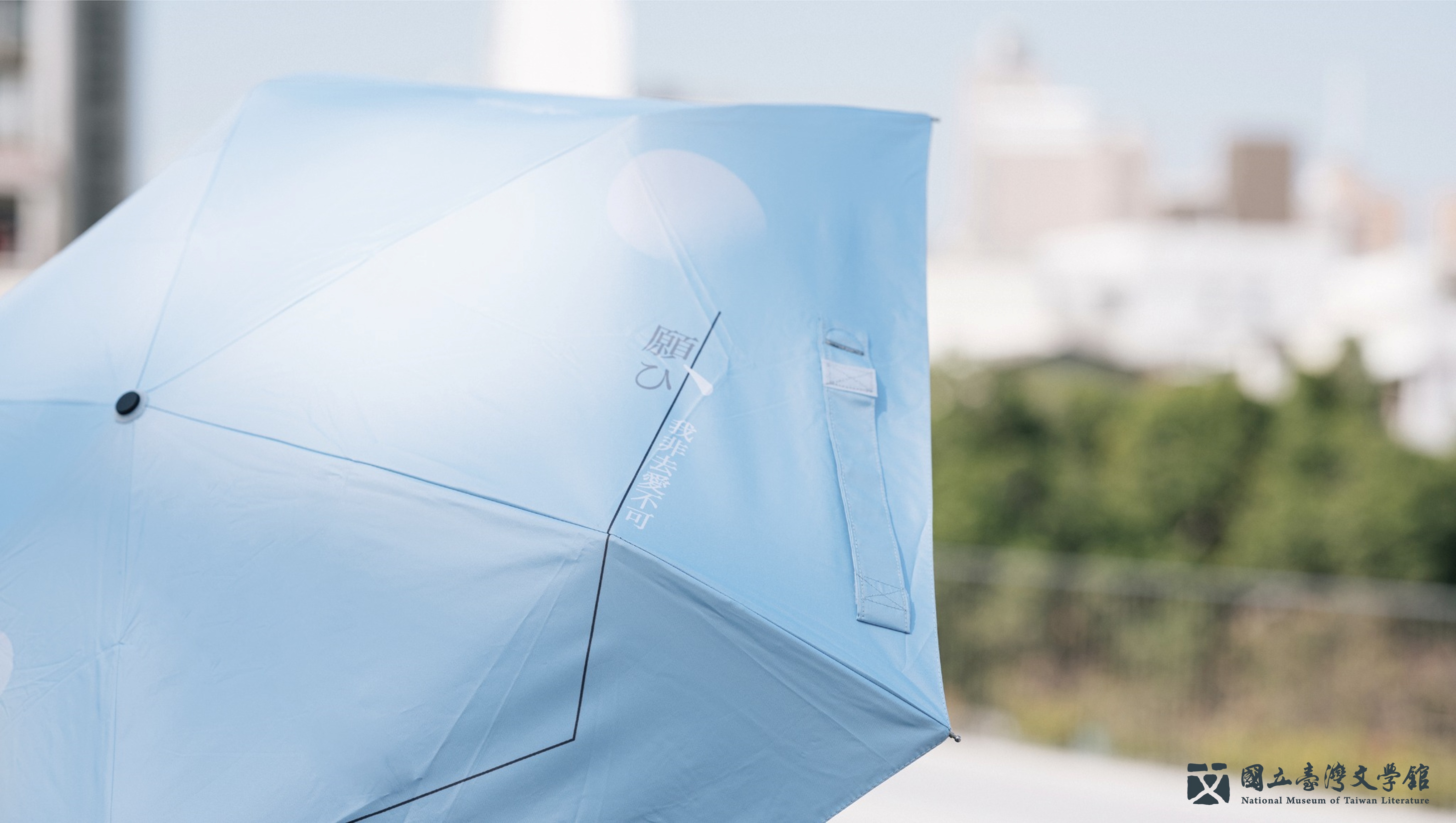
⭔ Sunlit Warmth 20 lightweight parasol
Lin Heng-tai published his Japanese-language poetry collection Birth Sounds of the Soul (Reikon no Ubugoe) in 1949 to inspire hope among his postwar Taiwanese compatriots. The face of the "Sunlit Warmth" parasol is printed in light-blue and warm-yellow tones. The several opaque, white globes across this scene represent the chilled voices of Taiwan's postwar poets, who were barred from commenting on the fate of their beloved island. Words in Chinese and Japanese are sprinkled as raindrops, with the titles of several poems defying the staid rules of diction. The black fabric layer underneath, reflecting Lin Heng-tai's despondent mood, presents a stark contrast to the parasol's light and cheery surface. However, the sturdy parasol pole evokes the pure and willful warmth that Heng-tai invariably felt for the world around him.(Photographed by 健識攝影-Jimmy C.C. Photography)
Hipsters' Playground—
Literary Keepsakes and Paraphernalia in Literary Translation
Compared with the fashion and trendiness of creative products, the literature products launched by National Museum of Taiwan Literature focus more on digging into the memories evoked by the artefacts, as well as their literature value and social meaning. The museum presents them in an elegant way; although they carry deep meanings, they are not serious at all. This article introduces the prototypes and literary stories of the stationery items developed by National Museum of Taiwan Literature.
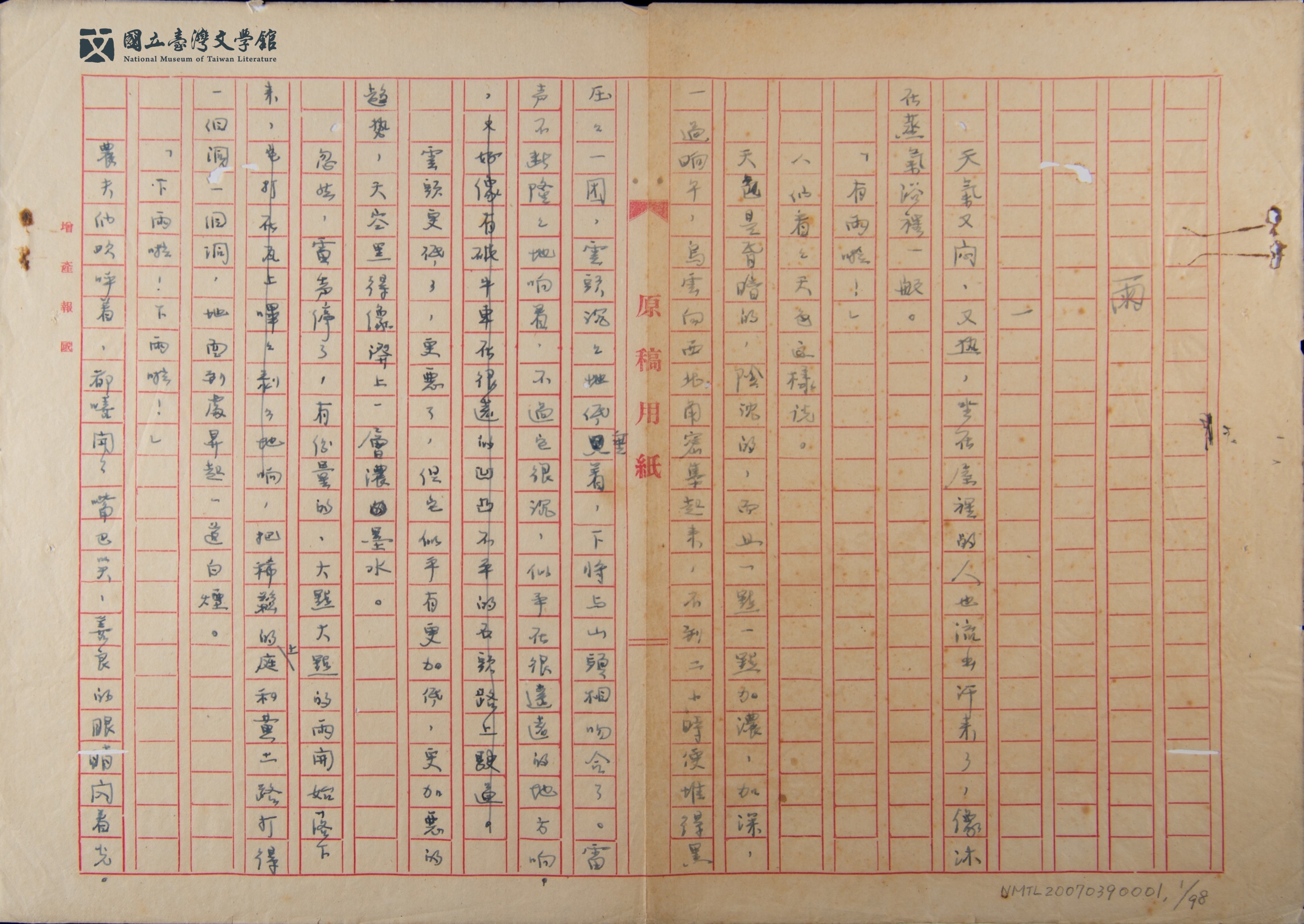
⭔ Chung Li-ho's "Rain"
Chung Li-ho (1915-1960), a native of Pingtung, graduated from Yanpu Public School during the Japanese colonial period and then attended a private academy to study classical Chinese, also beginning to explore the new literature that entered Taiwan at the time. While assisting his father in running the "Lishan Farm," he met Chung Taimai and later eloped with her to Fengtian, Manchuria, due to the objection of a same-surname marriage. After returning to Taiwan post-war, he suffered from lung disease. During his recuperation, he devoted himself to literary creation. In 1960, encouraged by Chung Chao-cheng, he completed "Rain" in early June; he died from coughing up blood on August 4 while revising the recently completed work. In his later years, Chung Li-ho was desperate about life and felt powerless in literature. Although he repeatedly warned his family, "There should not be another person involved in literature," he remained committed to literary creation after experiencing worldly suffering. (Kept in National Museum of Taiwan Literature)

⭔ Manuscript Fountain Pen
Chung Li-ho spent his final days on earth in poor health writing his final work, Rain. However, in spite of it all, his words ring elegantly crisp and true, surrounding the reader in the sights and smells of a countryside village after a refreshing rain. NMTL Archive Select reinterprets Rain and the life of Li-ho through the simplicity of a writer's pen. This pen, imprinted with a passage from Rain, is both a literary symbol and a statement. Together with its elegant package, this item encapsulates the author's idyllic image of a rain-quenched farming village and invites the reader in to enjoy the moment. Moreover, it celebrates the rarity of this pure, unaffected work, created during the author's final, difficult moments.
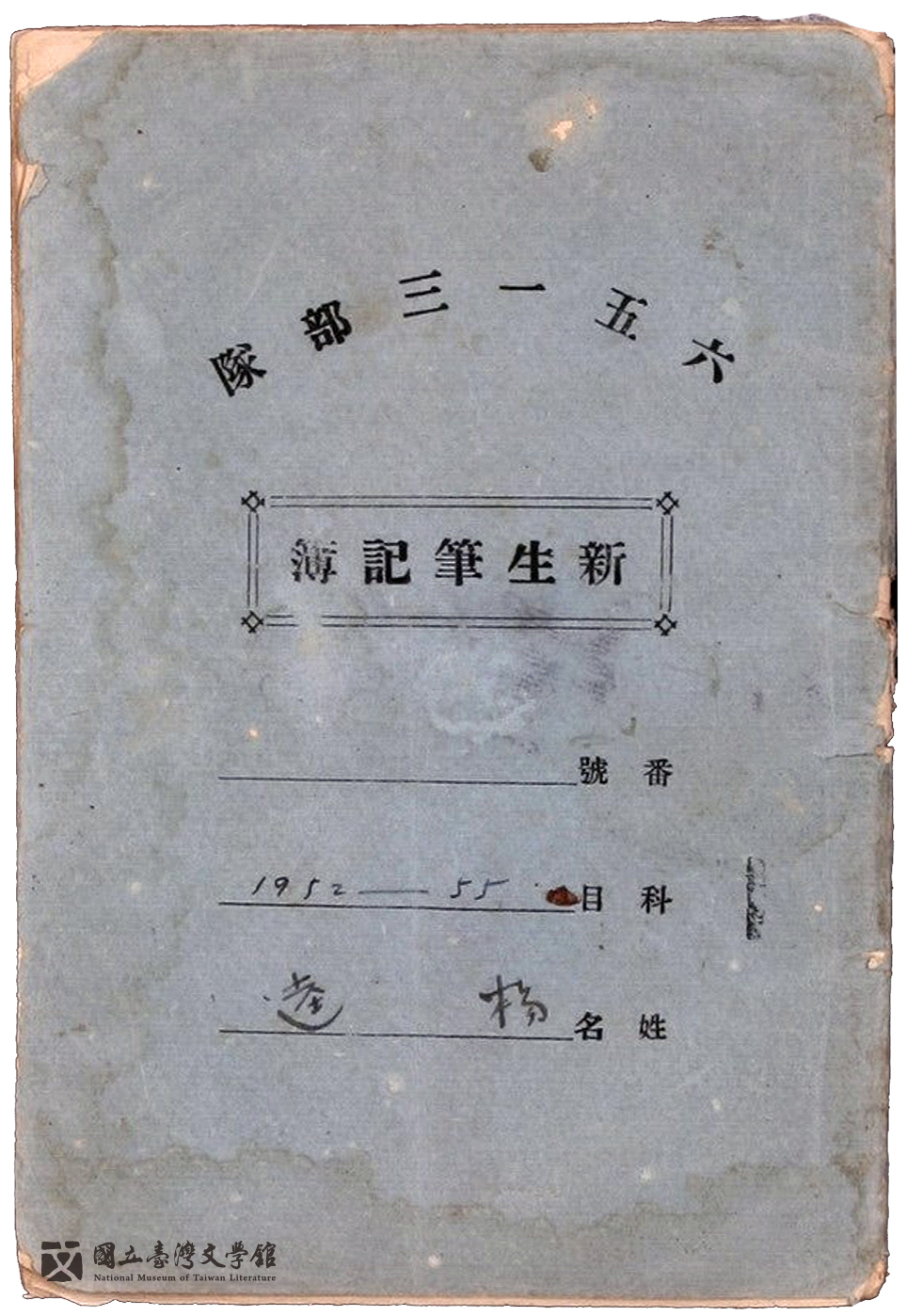
⭔ Yang Kuei's NEW LIFE NOTEBOOK
Yang Kuei (1906-1985), originally named Yang Gui, wrote under various pen names such as Yang Kuei, Yang Jian-wen, Lai Jian'er, SP, and Ito Ryō. Born in Xinhua, Tainan, he studied at the Department of Literature and Arts in a Japanese university- with a certificate of partial completion. In 1934, his piece "Newspaper Delivery Boy" won second prize in Tokyo's LITERARY REVIEW, making him the first Taiwanese writer to gain recognition in Japan's literary circles. In January 1949, he was imprisoned on Green Island for 12 years for drafting a "Peace Declaration." While in prison, he produced a large number of manuscripts, including poetry and proverbs, many of which were written in the "New Life Notebook." Both the first and last pages of the notebook have signs of intentional tearing, possibly due to censorship of its contents or deliberate destruction by Yang Kui. These marks and clues leave much room for readers' imagination. (Kept in National Museum of Taiwan Literature)
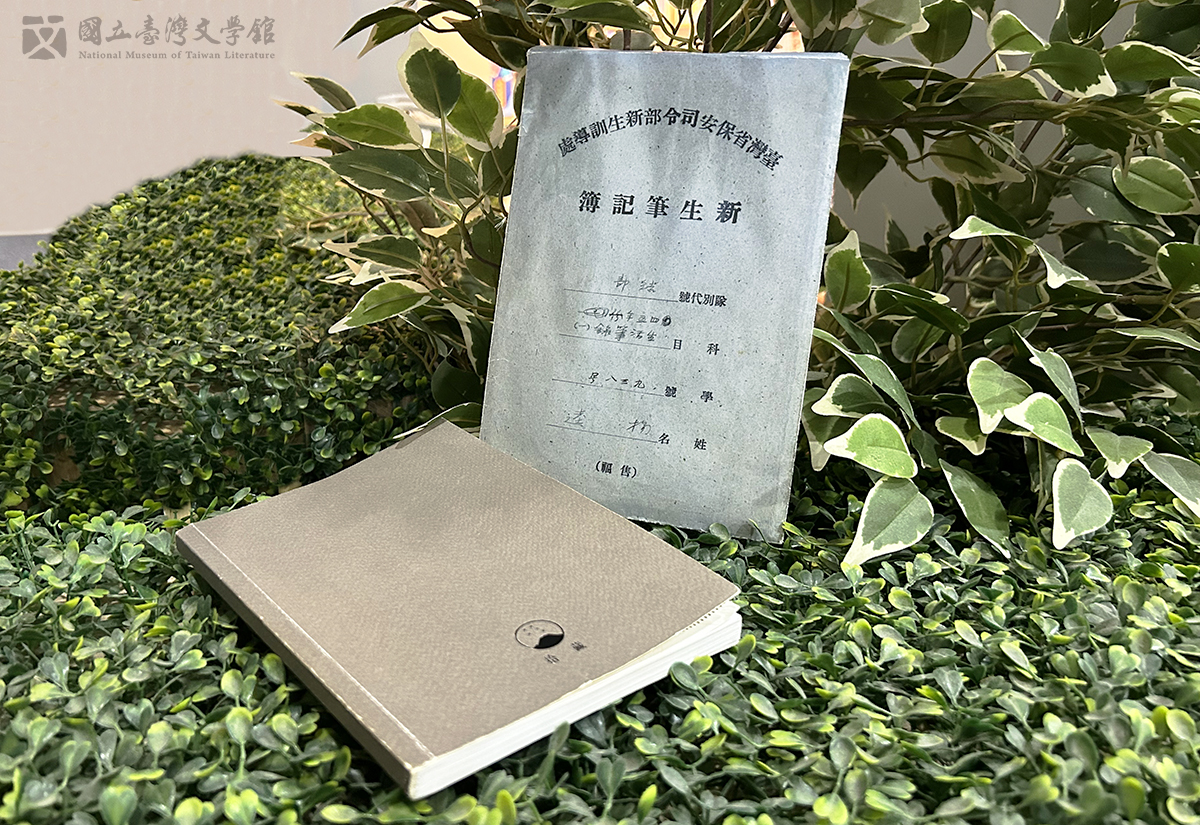
⭔ New Student's Notebook
The 'New Student's Notebook' is the NMTL's reinterpretation of the written records kept by Yang Kuei after his incarceration at Taiwan's Martial Law-era 'New Life Correction Center' for writing the article A Declaration of Peace in 1949, which criticized the new ROC regime's treatment of Taiwan following retrocession in 1945. This Archive Select item features a reproduction of the cover and envelope of the 'new student's notebook' distributed to all New Life Correction Center inmates. The dark brown shade of the cover evokes thoughts of the prison's dark, dank atmosphere and cares for the far-removed world outside as well as fond associations with the land and soil.

⭔ Taiwan Literary Federation Headquarters Wooden Plaque
In 1934, Zhang Shenqie, Lai Minghong, and other central Taiwan writers convened the first island-wide literary congress in Taichung. Members from the "Southern Tone Society," "Taiwan Art Research Association," and "Taiwan Literary Association," along with some new writers, all attended this oath-taking alliance. After the congress, they established the "Taiwan Literary Federation," Taiwan's earliest island-wide arts and literature organization, which is also the origin of this wooden plaque. In 1997, Zhang Shengyu, the son of Zhang Shenqie's younger brother, Zhang Huangyi, donated the plaque to the museum through Zhang Sunyu, Zhang Shenqie's descendant. Despite surviving wars, the February 28 Incident, the ups and downs of Zhang Shen-qie's post-war life, and family migrations, the wooden plaque remains in pristine condition, a truly valuable artifact. (Kept in National Museum of Taiwan Literature)
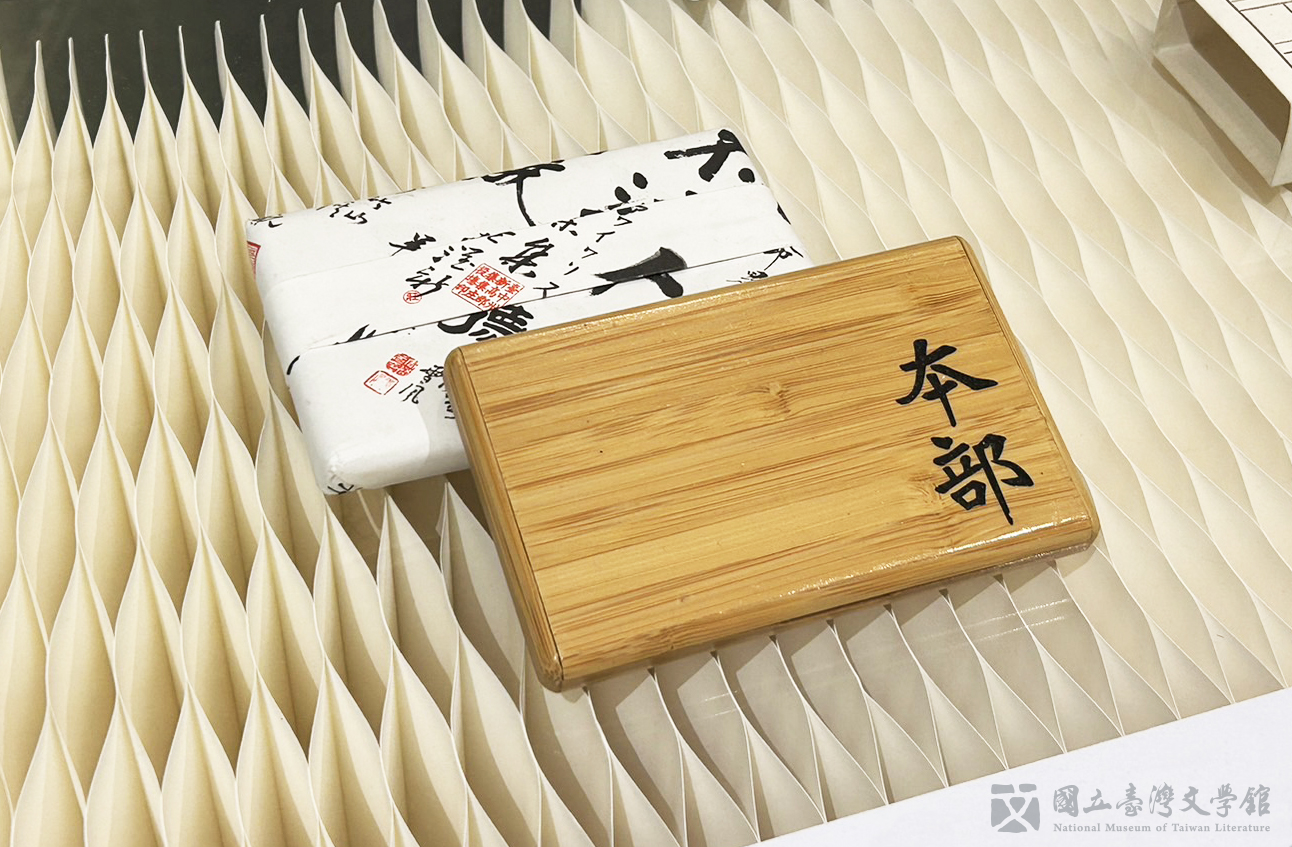
⭔ HQ Business Card Holder
The "Signature Card Holder" is developed by translating and combining the museum's collections of "The Celebrity Inscriptions Recorded by Zhang Shenqie During His Walking Tour" and the "Taiwan Literary Alliance Wooden Plaque". It contains fictional business cards of important member writers of the alliance. It imagines Zhang Shenqie enthusiastically introducing himself to both familiar and unfamiliar writers. Each exchange of a business card allows literature to contain infinite imagination and possibilities, guiding everyone to travel through time and space to participate in this grand historical event of Taiwan literature.
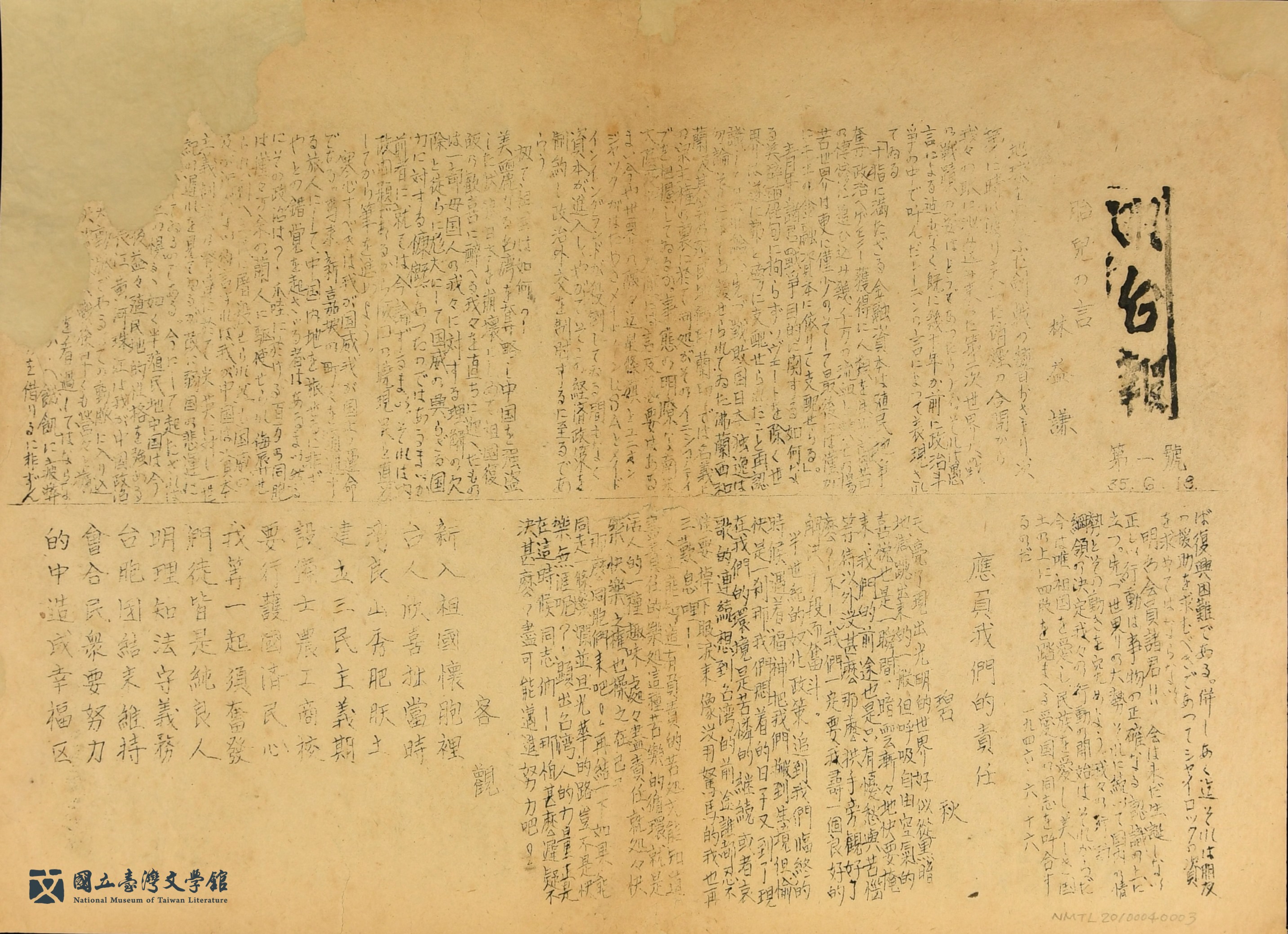
⭔ TAIWAN CLARITY NEWSLETTER First Issue
 After Japan's surrender in August 1945, Taiwanese Japanese soldiers were disbanded from their original units and formed "Taiwanese Compatriot Associations" in various prisoner-of-war camps. Upon graduating from high school, the semi-coerced "volunteer" soldier and poet Chen Chien-wu was also one of these Taiwanese Japanese soldiers. Initially, he waited in a Jakarta prisoner-of-war camp, and eventually, like other Taiwanese Japanese soldiers scattered across Southeast Asia, he reached the Singapore prisoner-of-war camp. While waiting to return home, thinking of Taiwan thousands of miles away, he decided to form the "Ming Taiwan Association" with his comrades and simultaneously launched the TAIWAN CLARITY NEWSLETTER, calling on compatriots to contemplate Taiwan's future. The TAIWAN CLARITY NEWSLETTER published five issues in total, with over 20 contributors. The content reflected the feelings of Taiwanese Japanese soldiers yearning to return home and their concerns for Taiwan's post-war future. (Kept in National Museum of Taiwan Literature)
After Japan's surrender in August 1945, Taiwanese Japanese soldiers were disbanded from their original units and formed "Taiwanese Compatriot Associations" in various prisoner-of-war camps. Upon graduating from high school, the semi-coerced "volunteer" soldier and poet Chen Chien-wu was also one of these Taiwanese Japanese soldiers. Initially, he waited in a Jakarta prisoner-of-war camp, and eventually, like other Taiwanese Japanese soldiers scattered across Southeast Asia, he reached the Singapore prisoner-of-war camp. While waiting to return home, thinking of Taiwan thousands of miles away, he decided to form the "Ming Taiwan Association" with his comrades and simultaneously launched the TAIWAN CLARITY NEWSLETTER, calling on compatriots to contemplate Taiwan's future. The TAIWAN CLARITY NEWSLETTER published five issues in total, with over 20 contributors. The content reflected the feelings of Taiwanese Japanese soldiers yearning to return home and their concerns for Taiwan's post-war future. (Kept in National Museum of Taiwan Literature)

⭔ Light of Dawn Pen & Ink Set
"Dawn" is a metaphor for the power of the pen. Ink marks the waning hours of darkness, as the light of wisdom begins to cast a warming glow across deep, tenebrous seas. As the darkness of war began to fade and the light of new hope emerged, Taiwanese could not but ponder their fate in a new and unfamiliar world. At war's end, many Taiwanese believed that their island, newly freed from Japanese colonial rule, would become self-governing. A lively debate, joined by Taiwanese far and wide (including prisoner-of-war Chen Chien-wu) ensued regarding how this might all be organized. Chen Chien-wu and his Taiwanese comrades-in-arms began publishing the Taiwan Clarity Newsletter to help platform the vibrant stream of thoughts and ideas on this timely topic.(Photographed by 健識攝影-Jimmy C.C. Photography)
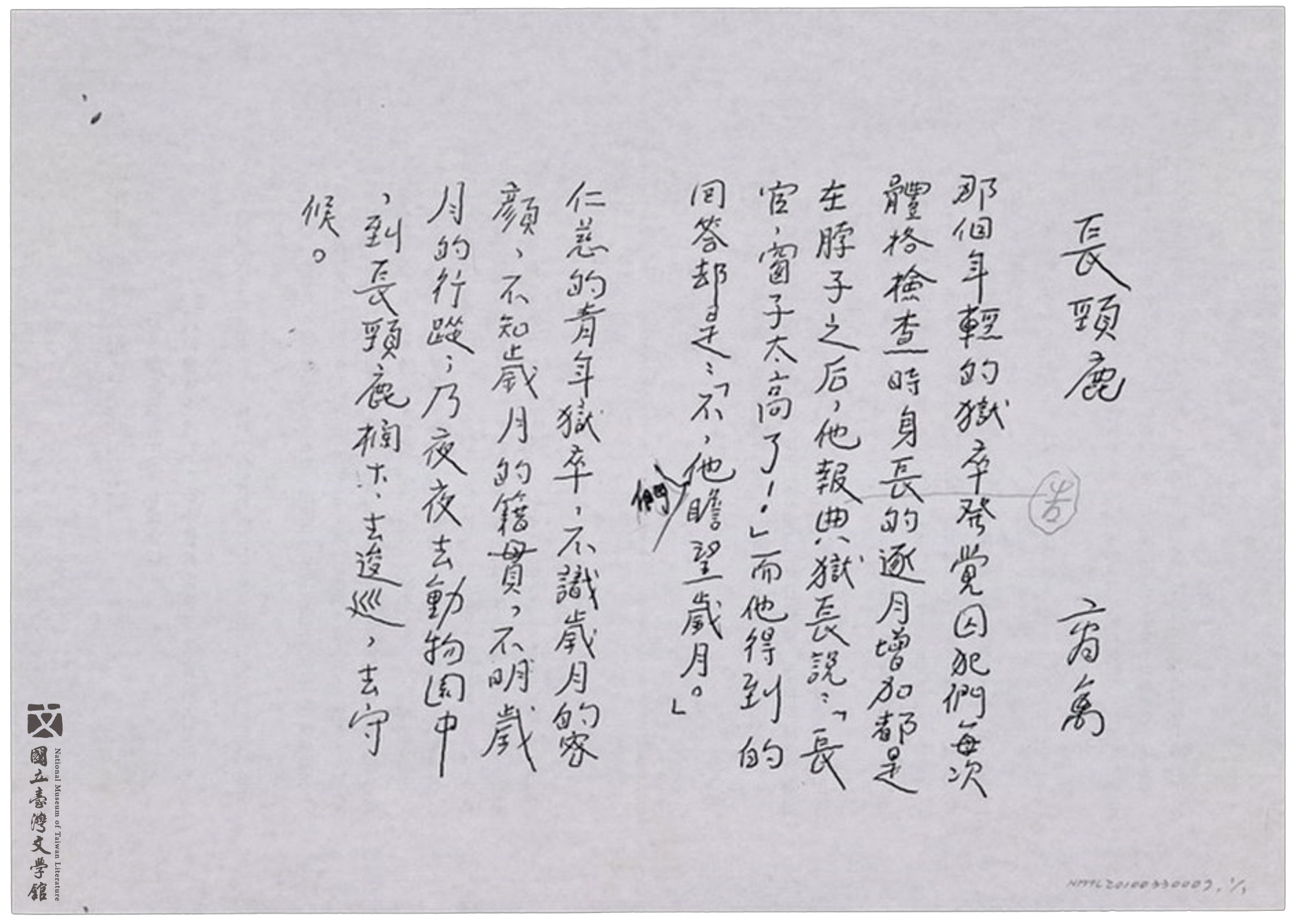
⭔ Shang Qin's "Giraffe"
Shang Qin (1930-2010), originally named Luo Xianxuan, was a stalwart of Taiwan's early "Modern Poetry Movement." He joined the army at 16, moved to Taiwan with his unit at 20, and held various jobs including editor, dockside temporary worker, gardener, beef noodle vendor, and even joined the Genesis Poetry Society. Shang Qin's prose poetry combines creativity and thought, emphasizing the use of imagery,variation of sentence structure, and the density and tension of poetry. "Giraffe" is included in DREAMS, AND OTHERS, and uses the relationship between the zoo and the giraffe as a metaphor for prisons and inmates, thereby presenting the absurdity of human existence and circumstances. (Kept in National Museum of Taiwan Literature)
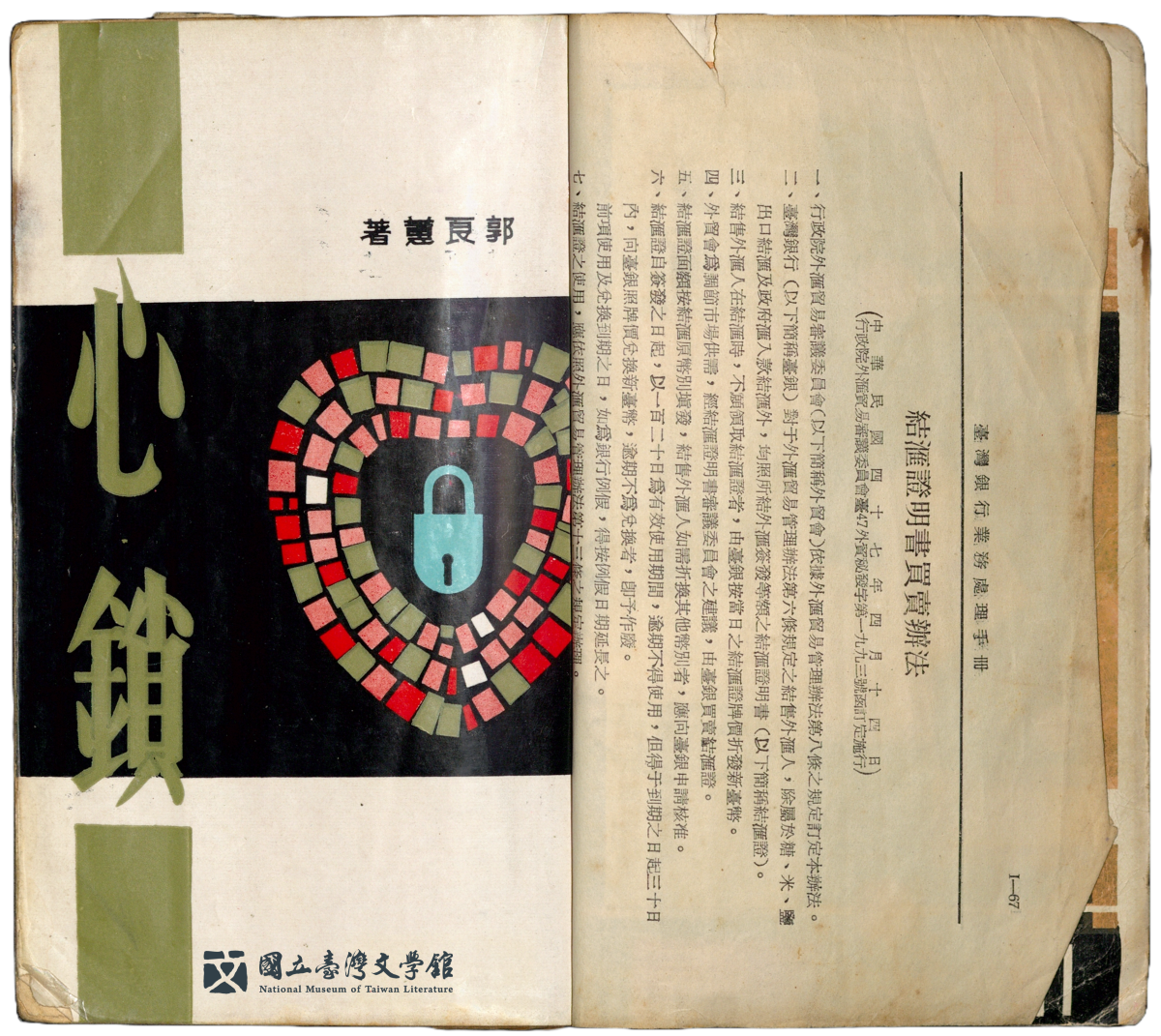
⭔ Guo Liang-hui's HEART LOCK
Guo Lianghui (1926-2013), originally from Shandong, graduated from the Foreign Language Department of Fudan University in Shanghai. She settled in Chiayi, Taiwan, with her husband in 1949. Known for her striking appearance and refined demeanor, she was dubbed "the most beautiful female writer." HEART LOCK was serialized in the ZHENGXIN NEWS from January 4 to June 19, 1962. The series generated controversy due to its themes and sexual content. After its formal publication by Tayeh Bookstore in 1963, it was banned during its third edition. Literary circles at the time primarily focused on its ethical standards. Critics such as Su Hsueh-lin and Xie Bing-ying vehemently argued that HEART LOCK was a "yellow novel" (pornographic) that encouraged "incest" and disrupted social order. In 1986, when Times Publishing included HEART LOCK in a collection of GUO LIANGHUI'S WORKS, it was banned for a second time. It was not until 1988 that the provincial government's news department lifted the ban. (Kept in National Museum of Taiwan Literature)
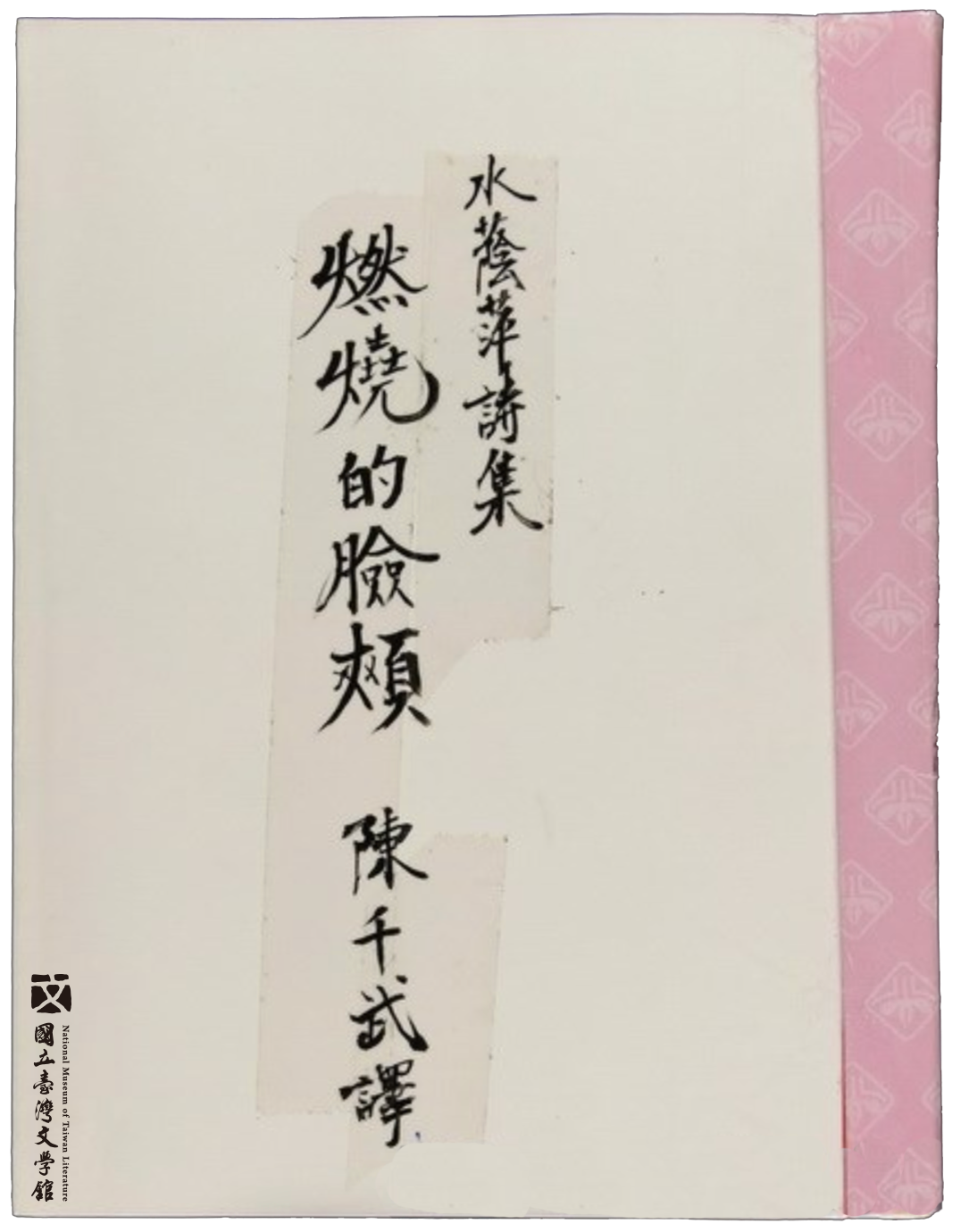
⭔ Shui Yinping's "Burning Cheeks"
Shui Yinping, born Yang Chi-chang, was a reporter for TAIWAN DAILY NEWS. In 1933, he founded the "Windmill Poetry Society" with Lin Xiu'er and Zhang Liang-dian, published the mimeographed poetry magazine LE MOULIN, introducing French surrealism into Taiwan, making him one of the pioneers of modernist literature during the Japanese colonial period. BURNING CHEEKS is Shui Yinping's third collection of poems, including poems written from 1933 to 1939 that were lost due to warfare, later translated by Chen Chien-wu. The collection begins with a "Preface Poem" titled "Self-Portrait" and ends with an "Afterword" describing the collection process, the author's poetic vision, origins of his poetics, and creative psychology. The eponymous poem "Burning Cheeks" employs surrealistic imagery to depict the alienation and loneliness of urban people. (Kept in National Museum of Taiwan Literature)
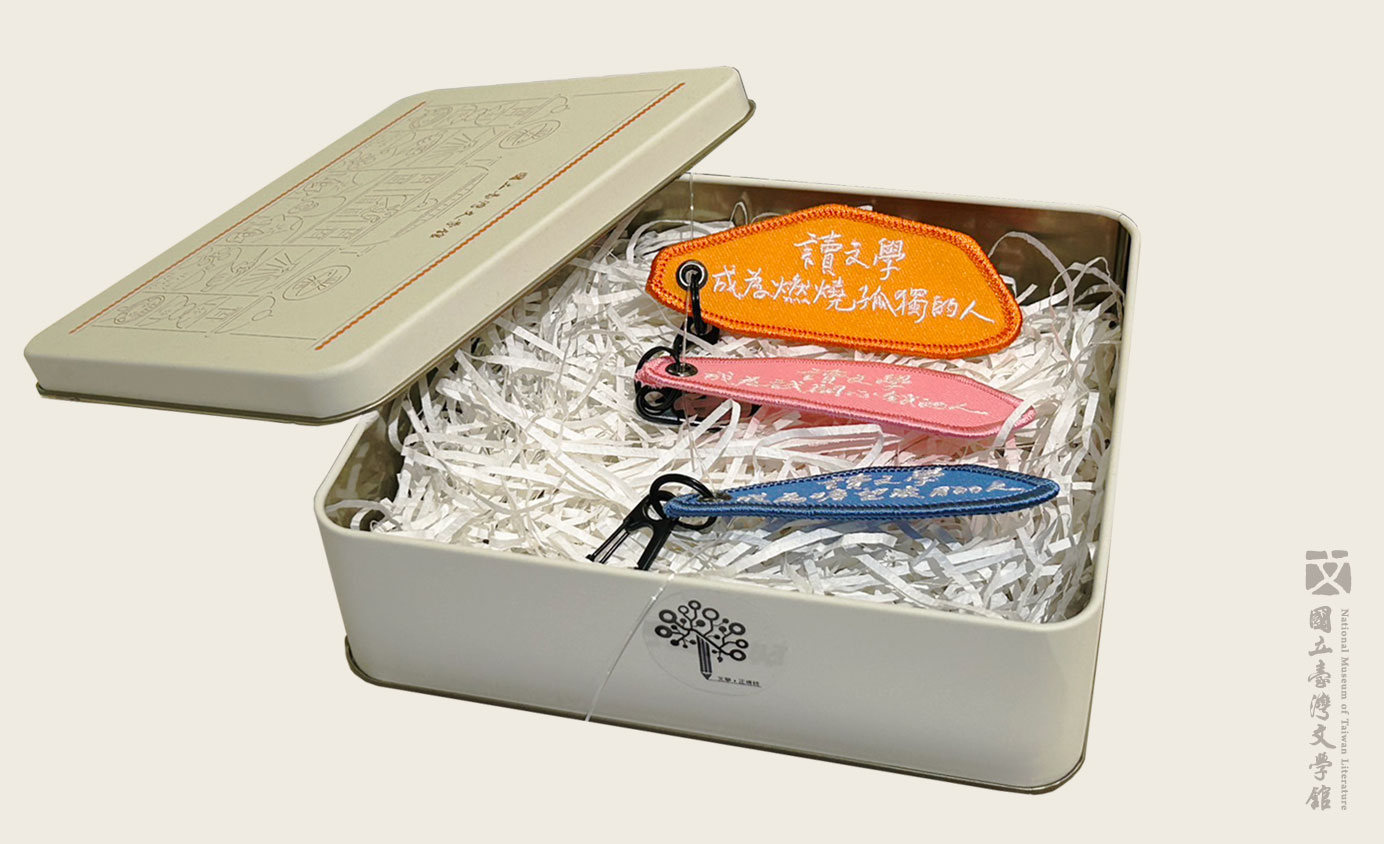
⭔ Reading Literature Keychain Set
"Read literature, become someone who looks forward to the years," pays tribute to Shang Qin's "Giraffe." "Read literature, become someone who tries to unlock hearts," pays tribute to Kuo Liang-hui's HEART LOCK. "Read literature, become someone who burns with loneliness," pays tribute to Yang Chi-chang's BURNING CHEEKS. These sentences span different times and spaces and are experienced, felt, and imagined by creators with diverse styles. As a result, literature gains a unique face.

